Class 10 Science Chapter 5 Periodic Classification of Elements NCERT Solutions
Before getting into the details of NCERT Solutions For Class 10 Science Chapter 5 Periodic Classification Of Elements, let’s have an overview of topics & subtopics under NCERT Solutions for class 10 science chapter 5 notes:
- Periodic Classification Of Elements
- Making Order Out Of Chaos – Early Attempts At The Classification Of Elements
- Making Order Out Of Chaos – Mendeléev’S Periodic Table
- Making Order Out Of Chaos – The Modern Periodic Table
- तत्वों के आवर्त वर्गीकरण कक्षा 10 विज्ञान हिंदी में
- Class 10 Periodic Classification of Elements Important Questions
- Periodic Classification of Elements Class 10 Notes
- Periodic Classification of Elements NCERT Exemplar Solutions
- Periodic Classification of Elements Class 10 Extra Questions
- Class 10 Periodic Classification of Elements Mind Map
NCERT Solutions for Class 10 Science Chapter 5 Intext Questions
Page Number: 81
Question 1
Did Dobereiner’s triads also exist in the columns of Newlands’ Octaves ? Compare and find out.
Answer:
Yes, Dobereiner’s triads also existed in the columns of Newland’s Octaves.
For example, Li, Na, K.
If we consider lithium (Li) as the first element, then sodium (Na) is eighth element. If we consider sodium as the first element, then potassium is the eighth element.
Question 2
What were the limitations of Dobereiner’s classification ?
Answer:
It failed to arrange all the then known elements in the form of triads of elements having similar chemical properties. Dobereiner could identify only three triads from the elements known that time.
Question 3
What were the limitations of Newlands’ law of octaves ?
Answer:
(i) Newlands law of octaves was applicable to the classification of elements upto calcium only. After calcium every eighth element did not possess the properties similar to that of the first element.
(ii) Newlands assumed that only 56 elements existed in nature and no more elements would be discovered in the future. But later on, several new elements were discovered whose properties did not fit into Newlands’ law of Octaves.
(iii) In order to fit elements into his table, Newlands put even two elements together in one slot and that too in the column of unlike elements having very different properties.
For example, the two elements cobalt (Co) and nickel (Ni) were put together in just one slot and that too in the column of elements like fluorine, chlorine and bromine which have very different properties from these elements.
(iv) Iron (Fe) element which resemble elements like cobalt and nickel in properties, was placed far away from these elements.
Page Number: 85
Question 1
Use Mendeleev’s Periodic Table to predict the formulae for the oxides of the following elements : K, C, Al, Si, Ba
Answer:
K2O, CO2, Al2O3, SiO2, BaO.
Question 2
Besides gallium, which other elements have since been discovered that were left by Mendeleev in his periodic table ? (any two)
Answer:
Scandium and Germanium.
Question 3
What were the criteria used by Mendeleev in creating his Periodic Table ?
Answer:
Mendeleev used the relationship between the atomic masses of the elements and their physical and chemical properties. He used similarity in physical properties, similarity in the formation of hydrides and oxides of element.
Question 4
Why do you think the noble gases are placed in a separate group ?
Answer:
Noble gases are chemically inert and are present in atmosphere in extremely low concentrations. Therefore, owing to their similar inert behaviour and similar electronic configuration, they are justified to be placed in a separate group.
Page Number: 90
Question 1
How could the modern periodic table remove various anomalies of Mendeleev’s periodic Table ?
Answer:
(i) The modern periodic table is based on atomic number, while Mendeleev’s periodic table was based on atomic mass.
(ii) The isotopes of an element have same number of protons (or atomic number). So they are alloted the same position in modern periodic table.
(iii) Cobalt and nickel are placed at 9th and 10th position respectively.
(iv) Hydrogen has been alloted special position, i.e., it is placed at the top of alkali metals in the first group.
Question 2
Name two elements you would expect to show chemical reactions similar to magnesium. What is the basis for your choice ?
Answer:
Beryllium (Be) and Calcium (Ca).
Both Be (atomic number 4) and Ca (atomic number 20) have similar electronic configuration, i.e. two electrons in outermost shells.
Be 2,2
Ca 2, 8, 8, 2
Both Be and Ca react with oxygen to give basic oxides, BeO and MgO.
Question 3
Name :
(a) three elements that have a single electron in their outermost shells.
(b) two elements that have two electrons in their outermost shells.
(c) three elements with filled outer most shells.
Answer:
(a) Lithium : Atomic number – 3(2, 1); Sodium : Atomic number – 11(2, 8, 1); Potassium : Atomic number – 19(2, 8, 8, 1).
(b) Beryllium : Atomic number – 4(2, 2); Calcium : Atomic number – 20(2, 8, 8, 2)
(c) Helium : Atomic number – 2(2); Neon : Atomic number – 10(2, 8); Argon : Atomic number – 18(2, 8, 8).
Question 4
(a) Lithium, sodium, potassium are all metals that react with water to liberate hydrogen gas. Is there any similarity in the atoms of these elements ?
(b) Helium is an unreactive gas and neon is a gas of extremely low reactivity. What, if anything, do their atoms have in common ?
Answer:
(a) Lithium, sodium and potassium all belong to the same group. The atoms of lithium, sodium and potassium all have only one electron in their outermost shells and all of these are metals. All of these react with water to form alkalies.
(b) The atoms of helium and neon have their outermost shells completely filled. Helium has its first shell completely filled, while neon has its first and second shells (K and L) completely filled.
Question 5
In the modern periodic table, which are the metals among the first ten elements ?
Answer:
The first ten elements in modern periodic table are hydrogen, helium, lithium, beryllium, boron, carbon, nitrogen, oxygen, fluorine and neon. Out of these, lithium, beryllium and boron are metals, because they have 1, 2 and 3 electrons respectively in their outermost shells.
Question 6
By considering their position in the Periodic Table, which one of the following elements would you expect to have maximum metallic characteristics ?
Ga, Ge, As, Se, Be
Answer:
Beryllium (Be). In the periodic table, the elements placed on the left show maximum metallic characteristics. Since beryllium occupies the most left position in comparison to other elements, hence it shows maximum metallic characteristics.
NCERT Solutions for Class 10 Science Chapter 5 Textbook Chapter End Questions
Question 1
Which of the following statements is not a correct statement about the trends wlien going from left to right across the periods of Periodic Table.
(a) The elements become less metallic in nature.
(b) The number of valence electrons increases.
(c) The atoms lose their electrons more easily.
(d) The oxides become more acidic.
Answer:
(c) The atoms lose their .electrons more easily.
Question 2
Element X forms a chloride with the formula XCl2, which is solid with a high melting point. X would most likely to be in the same group of the periodic table as
(a) Na
(b) Mg
(c) Al
(d) Si
Answer:
(b) Mg
Question 3
Which element has
(a) two shells, both of which are completely filled with electrons ?
(b) the electronic configuration 2, 8, 2 ?
(c) a total of three shells, with four electrons in its valence shell ?
(d) a total of two shells with three electrons in its valence shell. v
(e) twice as many electrons in its second shell as in its first shell ?
Answer:
(a) Neon (2, 8)
(b) Magnesium
(c) Silicon (2, 8, 4)
(d) Boron (2, 3)
(e) Carbon (2, 4)
Question 4
(a) What property do all elements in the same column of the Periodic Table as boron have in common ?
(b) What property do all elements in the same column of the Periodic Table . as fluorine have in common ?
Answer:
(a) Elements in the same column or group as boron have valency of three and have three valence electrons.
(b) Elements in the same column or group as fluorine form acidic oxides and have seven electrons in their outermost shells and have valency of one.
Question 5
An atom has electronic configuration 2, 8, 7.
(a) What is the atomic number of this element ?
(b) To which of the following elements would it be chemically similar ? (Atomic numbers are given in parentheses.)
N (7), F (9), P (15), Ar (18)
Answer:
(a) The atomic number of the given element is 2 + 8 + 7(= 17).
(b) It would be chemically similar to fluorine [F(9)] because its electronic configuration is 2, 7.
Question 6
The positions of three elements A, B and C in the periodic table are shown below :
(a) State whether A is a metal or non-metal.
| Group 16 | Group 17 |
| – | – |
| – | A |
| – | – |
| B | C |
(b) State whether C is more reactive or less reactive than A.
(c) Will C be larger or smaller in size than B ?
(d) Which type of ion, cation or anion, will be formed by element A ?
Answer:
(a) Since the valency of group 17 elements is 1 and all these elements accept electrons, thus A is a non-metal.
(b) C is less reactive than A because as we move down in a group, the reactivity of non-metals increases.
(c) C is smaller in size than B because B and C both are related to the same period and the size decreases as one moves from left to right in a period.
(d) A will form anion because it is a non-metal.
Question 7
Nitrogen (atomic number 7) and phosphorus (atomic number 15) belong to group 15 of the periodic table. Write the electronic configuration of these two elements. Which of these will be more electronegative ? Why ?
Answer:
Electronic configuration of nitrogen -2,5
Electronic configuration of phosphorus = 2, 8, 5
Nitrogen will be more electronegative because outermost shell is nearer to nucleus and therefore nucleus will attract electrons more strongly. In a group of the periodic table, electron attracting tendency decreases as we move from top to bottom.
Question 8
How does the electronic configuration of an atom relate to its position in the Modern Periodic Table ?
Answer:
Modern periodic table is based on the atomic number and atomic number is directly related to the electronic configuration. One can find the group number and period number of an element on the basis of electronic configuration. For example, if an element has 1 or 2 electrons in its outermost shell, then it would belong to group 1 or group 2. And if it has 3 or more electrons in its outermost shell, then it would belong to group 10 4- the number of electrons in the outermost shell.
All the alkali metals have one electron in their outermost shell, so they are placed in group 1. Thus, all the group 2 elements have 2 electrons in their outermost shell. In group 15 elements, there are 5 electrons in their outermost shell. Similarly, the number of shells in an element indicates its period number. For example, the atomic number of magnesium is 12 and its electronic configuration is 2, 8, 2. Thus it is an element of 3rd period.
Question 9
In the Modern Periodic Table, calcium (atomic number 20) is surrounded by elements with atomic number 12, 19, 21 and 38. Which of these have physical and chemical properties resembling calcium ?
Answer:
The electronic configuration of elements with :
Atomic number 12 = 2, 8, 2
Atomic number 19 = 2, 8, 8, 1
Atomic number 20 = 2, 8, 8, 2
Atomic number 21 = 2, 8, 9, 2
Atomic number 38 = 2, 8, 18, 8, 2
Elements with atomic number 12 i.e., magnesium (Mg) and 38 i.e., strontium (Sr) will have similar physical and chemical properties as element with atomic numbers 20 i.e., calcium (Ca).
Question 10
Compare and contrast the arrangement of elements in Mendeleev’s Periodic Table and the Modern Periodic Table.
Answer:
| Mendeleev’s Periodic Table | Modern Periodic Table |
| (i) Elements are arranged in the order of increasing atomic mass. | (i) Elements are arranged in the order of increasing atomic number. |
| (ii) There are nine vertical columns called groups. | (ii) There are eighteen vertical columns called groups. |
| (iii) There is no place for noble gases. | (iii) Noble gases are placed on the right hand side of the table. |
| (iv) There is no place for isotopes. | (iv) Isotope are kept at the same place because their atomic number is same. |
| (v) Transition elements are placed together in group VIII. | (v) Transition elements are placed in the middle of the long period (Group 3 to 12). |
| Board | CBSE |
| Textbook | NCERT |
| Class | Class 10 |
| Subject | Science |
| Chapter | Chapter 4 |
| Chapter Name | Periodic Classification of Elements |
| Number of Questions Solved | 23 |
| Category | NCERT Solutions |
NCERT Solutions for Class 10 Science Chapter 5 Periodic Classification of Elements
Periodic classification of elements: Needs for classification, Modern Periodic table, gradation in properties, valency, atomic number, metallic and non-metallic properties.
Formulae Handbook for Class 10 Maths and Science
Question 1
Did Dobereiner’s triads also exist in the columns of Newlands Octaves? Compare and find out.
Solution:
Yes, Dobereiner’s triads also exist in the columns of Newlands Octaves. For example, the second column of Newlands classification has the elements lithium (Li), sodium (Na) and Potassium (K), which constitute a Dobereiner’s triad.
Question 2
What were the limitations of Dobereiner’s classification?
Solution:
All the known elements could not be arranged in the form of triads. For very low mass or for very high mass elements, the Dobereiner’s triads are not applicable. Take the example of F, Cl and Br. Atomic mass of Cl is not an arithmetic mean of atomic masses of F and Br. As the techniques for measuring atomic masses accurately, improved, the Dobereiner’s triad was unable to remain strictly valid.
More Resources
- NCERT Solutions
- NCERT Solutions for Class 10 Science
- NCERT Solutions for Class 10 Maths
- NCERT Solutions for Class 10 Social
- NCERT Solutions for Class 10 English
- NCERT Solutions for Class 10 Hindi
- NCERT Solutions for Class 10 Sanskrit
- NCERT Solutions for Class 10 Foundation of IT
- RD Sharma Class 10 Solutions
Question 3
What were the limitations of Newland’s Law of Octaves?
Solution:
It was not valid for elements that had atomic masses higher than Ca.When more elements were discovered, such as elements from the noble gases such as He, Ne, Ar, they could not be accommodated in his table.
Download NCERT Solutions for Class 10 Science Chapter 5 Periodic Classification of Elements PDF
Question 4
Use Mendeleev’s periodic table to predict the formulae for the oxides of the following elements: K, C, Al, Si, Ba.
Solution:
K2O – Potassium Oxide
CaO – Calcium Oxide
Al2O3 – Aluminium Oxide
SiO2 – Silicon dioxide
BaO – Barium Oxide.
Question 5
Besides gallium, which other elements have been left by Mendeleev in his periodic table, since the time they were discovered? (Any two)
Solution:
Scandium and Germanium.
Question 6
What were the criteria used by Mendeleev in creating his periodic table?
Solution:
He observed the relationship between the atomic masses of the elements and their physical properties. Among chemical properties, he concentrated on the compounds formed by elements with oxygen and hydrogen.
Question 7
Why do you think, the noble gases are placed in a separate group?
Solution:
Due to its inert and low concentration in our atmosphere, they could be placed in a new group without disturbing the existing order.
Question 8
How could the Modern periodic table remove various anomalies of Mendeleev’s periodic table?
Solution:
When the elements are arranged according to their atomic numbers on the basis of modern periodic law, all the anomalies (defects) of Mendeleev’s classification disappear. For example, Position of isotopes: All the isotopes of an element have the same number of protons, so their atomic number is also the same. Since all the isotopes of an element have the same atomic number, they can be put at one place in the same group of the periodic table.
Question 9
Name two elements, which you would expect to show chemical reactions similar to magnesium. What is the basis for your choice?
Solution:
Calcium and Beryllium are the elements that will show chemical reactions similar to magnesium. This is because beryllium and calcium belong to the same group of periodic table as magnesium. All of them have similar electronic configurations with 2 valence electrons each.
Question 10
Name:
a. Three elements that have a single electron in their outermost shell.<
b. Two elements that have two electrons in their outermost shell.<
c. Three elements with filled outermost shell.
Solution:
a. Three elements that have a single electron in their outermost shell are:
1. Lithium
2. Sodium
3. Potassium
b. Two elements that have two electrons in their outermost shell are:
1. Magnesium
2. Calcium
c. Three elements with filled outermost shell are:
1. Argon
2. Helium
3. Neon.
Question 11
a. Lithium, sodium, potassium are metals that react with water to liberate hydrogen. Is there any similarity in the atoms of these elements?
b. Helium is an unreactive gas and neon is a gas of extremely low reactivity. What, if anything, do their atoms have in common
Solution:
a. These elements are alkali metals and they have 1 valence electron in their outermost shell and are therefore very unstable and reactive.
b. These elements each have full outermost subshell, which results in high stability. They only react with other elements in extreme circumstances, the trait for which they are named.
Question 12
In the Modern periodic table, which are the metals among the first ten elements?
Solution:
The metals are Lithium and Beryllium.
Question 13
By considering their position in the periodic table, which one of the following elements would you expect to have maximum metallic characteristic?
Ga, Ge, As, Se, Be
Solution:
Beryllium
Question 14
Which of the following statements is not a correct statement about the trends when going from left to right across the periods of the periodic table?<
(i)The elements become less metallic in nature
(ii) The number of valence electrons increases
(iii) The atoms lose their electrons more easily
(iv) The oxides become more acidic
Solution:
(iii) The atoms lose their electrons more easily – Incorrect statement.
Question 15
Element X forms a chloride with the formula XCl2, which is a solid with a high melting point. X would most likely be in the same group of the periodic table as
a. Na b. Mg c. Al d. Si
Solution:
b. Mg
Question 16
Which element has?
a.Two shells, both of which are completely filled with electrons?<
b. The electronic configuration of 2,8,2?<
c. A total of three shells, with four electrons in its valence shell?<
d. A total of two shells, with three electrons in its valence shell?<
e. Twice as many electrons in its second shell, as in its first shell?
Solution:
a. Neon (2,8)
b. Magnesium (2,8,2)
c. Silicon (2,8,4)
d. Boron (2,3)
e. Carbon (2,4)
Question 17
What property do all elements in the same column of the periodic table as fluorine have in common?
Solution:
These elements all have 7 electrons in their outermost shells and these often exist as salts, combined with elements from the Alkali metal group.
Question 18
An atom has electronic configuration 2,8,7.
i. What is the atomic number of this element?
ii. To which of the following elements would it be chemically similar<
N (7) F (9) P (15) Ar (18)
Solution:
(i) Chlorine – 17
(ii) F (9)
Question 19
Which type of ion, cation or anion, will be formed by element A?
Solution:
C is less reactive than A
“C” will be smaller in size than “B” as the atomic size decreases as we go across a period.
Anion will be formed by element A
Question 20
Nitrogen (atomic number 7) and phosphorus (atomic number 15) belong to group 15 of the periodic Table. Write the electronic configuration of these two elements. Which of these will be more electronegative? Why?
Solution:
Electronic configuration – Nitrogen – 2s2 2p3 and Phosphorus – 1s2 2s2 2p6 3s2 3p3. Nitrogen will be more electronegative; this is because its atom has small size due to which the attraction of its nucleus for the incoming electron is more.
Question 21
How does the electronic configuration of an atom relate to its position in the Modern periodic table?
Solution:
The electronic configuration of an atom increases in the outermost valence shell which relates to its position in the Modern periodic table.
Question 22
In the Modern periodic table, calcium (atomic number 20) is surrounded by elements with atomic numbers 12, 19, 21 and 38. Which of these have physical and chemical properties resembling calcium?
Solution:
The atomic number of calcium is 20, so its electronic configuration is 2, 8, 8, 2. Thus, calcium has 2 valence electrons (in its outermost shell). Now, the element which has 2 valence electrons, will have physical and chemical properties resembling to that of calcium. The electronic configuration of element having atomic number 12 is 2, 8, 2. It has 2 valence electrons just like calcium. So, the element having atomic number 12 will have physical and chemical properties resembling that of calcium.
Question 23
Where do you think should hydrogen be placed in the Modern periodic table?
Solution:
Hydrogen element has been placed at the top of group 1, above the alkali metals because the electronic configuration of hydrogen is similar to those of alkali metals.
Multiple Choice Questions (MCQs) [1 Mark each]
Question 1.
Which of the following is the outermost shell for elements of 2nd period? [NCERT Exemplar]
(a) K-shell
(b) L-shell
(c) M-shell
(d) N-shell
Answer:
(b) The elements of 2nd period involve the filling of 2nd shell, i.e. Z-shell. Because in period 2, there are two shell, K and L
Question 2.
An element which is an essential constituent of all organic compounds belongs to [NCERT Exemplar]
(a) group 1
(b) group 14
(c) group 15
(d) group 16
Answer:
(b) Constituent of all organic compounds is carbon. It belongs to group 14.
Question 3.
Which one of the following elements exhibit maximum number of valence electrons? [NCERT Exemplar]
(a) Na
(b) Al
(c) Si
(d) P
Answer:
(d) Na (group 1) has one, A1 (group 13) has three (13 -10), Si (group 14) has four (14-10) and P (group 15) has five (15 – 10) valence electrons. Therefore, P has maximum number of valence electrons, i.e.3 (maximum among the given elements).
Question 4.
Which of the given elements A, B, C, D and E with atomic number 2, 3, 7, 10 and 30 respectively belong to the same period? [NCERT Exemplar]
(a) A, B, C
(b) B, C, D
(c) A, D, E
(d) B, D, E
Answer:
(b) 2nd period contains elements with atomic number 3(Li), 7(N), 10(Ne). Since, 2nd period has elements having atomic number 3 to 10.
Question 5.
The elements A, B, C, D and E have atomic number 9, 11, 17, 12 and 13 respectively. Which pair of elements belong to the same group? [NCERT Exemplar]
(a) A and B
(b) B and D
(c) A and C
(d) D and E
Answer:
(c)Electronic configuration of A (atomic number = 9) is 2, 7.
Electronic configuration of B (atomic number = 11) is 2, 8,1.
Electronic configuration of C (atomic number = 17) is 2, 8, 7.
Electronic configuration of D (atomic number =12) is 2, 8, 2.
Electronic configuration of E (atomic number =13) is 2, 8, 3.
Elements which differ in atomic number by 8, i.e. 9 (A, fluorine) and 17 (C, chlorine) lie in the same group, i.e. group 17 (halogen).
Question 6.
In Mendeleev’s periodic table, gaps were left for the elements to be discovered later. Which one of the following elements found a place in the periodic table later? [NCERT Exemplar]
(a) Germanium
(b) Chlorine
(c) Oxygen
(d) Silicon
Answer:
(a) Mendeleev’s left some gaps in the periodic table for those elements which were not known at that time. Germanium element found a place in the periodic table later and Mendeleev’s predictions were found to be remarkably correct
Question 7.
Which of the following are the characteristics of isotopes of an element? [NCERT Exemplar]
(i) Isotopes of an element have same atomic masses.
(ii) Isotopes of an element have same atomic number.
(iii) Isotopes of an element show same physical properties.
(iv) Isotopes of an element show same chemical properties.
(a) (i), (iii) and (iv)
(b) (ii), (iii) and (iv)
(c) (ii) and (iii)
(d) (ii) and (iv)
Answer:
(d) Isotopes of an element have same atomic number and show same chemical properties.
Question 8.
Which of the following elements would lose an electron easily? [NCERT Exemplar]
(a) Mg
(b) Na
(c) K
(d) Ca
Answer:
(c) Electronic configuration of Mg (atomic number = 12) 2, 8, 2
Electronic configuration of Na (atomic number = 11)2, 8, 1
Electronic configuration of K (atomic number=19) 2, 8, 8, 1
Electronic configuration of Ca (atomic number =20) 2, 8, 8, 2
From the above electronic configurations, it is clear that K and Na will lose electron easily to achieve stable configuration. But out of K and Na, K will lose electron more easily because the force of, attraction on valence electron of K is least among the given elements.
Question 9.
Which among the following elements has the largest atomic radii? [NCERT Exemplar]
(a) Na
(b) Mg
(c) K
(d) Ca
Answer:
(c) Atomic radius increases on moving down in a group. Na and K are in the same group and K is below Na, so K will have higher atomic radius, i.e. K > Na. In a period on moving left to right, atomic radius decreases. Since, K and Ca are in the same period and K is in 1st group and Ca is in 2nd group, so atomic radius of K will be more than Ca, i.e. K > Ca.
Also Na and Mg are in the same period, but Na belongs to 1st group and Mg belongs to 2nd group, so atomic radius of Na is more than Mg, i.e. Na > Mg. Thus, if we take all these together we get K > Na >Mg and K > Ca > Mg. Hence, we can say that the atomic radius of K is largest.
Question 10.
Which of the following statements is not a correct statement about the trends when going from left to right across the periods of periodic table? [NCERT]
(a) The elements become less metallic in nature
(b) The number of valence electrons increases
(c) The atoms lose their electrons more easily
(d) The oxides become more acidic
Answer:
(c) On moving from left to right, the atomic number increases and hence, the nude charge increases. With the increase of nudear charge, the force binding the electron increases so the atom lose the electrons with more difficulty, not easily.
Question 11.
Which one of the following depicts the correct representation of atomic radius (r) of an atom? [NCERT Exemplar]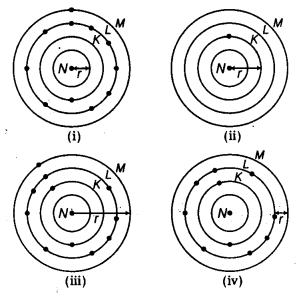
(a) (i) and (i)
(b) (ii) and (iii)
(c) (iii) and (iv)
(d) (i) and (iv)
Answer:
(b) Atomic radius is the distance between nucleus and outermpst shell [consisting electron(s)]. Hence (ii) and (iii) are the correct representations.
Question 12.
Which of the following statement(s) about the modern periodic table are incorrect?
(i) The elements in the modern periodic table are arranged on the basis of their decreasing atomic numbers.
(ii) The elements in the modern periodic table are arranged on the basis of their increasing atomic masses.
(iii) Isotopes are placed in adjoining group(s) in the periodic table.
(iv) The elements in the modern periodic table are arranged on the basis of their increasing atomic number. [NCERT Exemplar]
(a) Only (i)
(b) (i), (ii) and (iii)
(c) (i), (ii) and (iv)
(d) Only (iv)
Answer:
(b) Only statement (iv) is correct. All the elements in the modern periodic table are arranged on the basis of their increasing atomic number. All the isotopes can be placed at one place in the same group of the periodic table.
Question 13.
The element with atomic number 14 is hard and forms acidic oxide and a covalent halide. To which of the following categories does the element belong? [NCERT Exemplar]
(a) Metal
(b) Metalloid
(c) Non-metal
(d) Left-hand side element
Answer:
(c) Its outermost shell has 4 electrons. So, it is a non-metal. Non-metal forms acidic oxide and by sharing of electrons with halogen, it forms covalent halide.
Question 14.
Arrange the following elements in the order of their decreasing metallic character Na, Si, Cl, Mg, Al. [NCERT Exemplar]
(a) Cl > Si > Al > Mg > Na
(b) Na > Mg > Al > Si > Cl
(c) Na > Al > Mg > Cl > Si
(d) Al > Na > Si > Ca > Mg
Answer:
(b) Metals lie on the extreme left side of the periodic table. Metallic character decreases from left to right in a period. Na, Si, Cl, Mg, Al belong to same period in the order Na, Mg, Al, Si, Cl. On moving in a i period from left to right, the metallic character decreases. Thus, the order of decreasing metallic character is: Na > Mg > Al > Si > Cl
Question 15.
Which of the following set of elements is written in order of their increasing metallic character? [NCERT Exemplar]
(a) Be, Mg, Ca
(b) Na, Li, K
(c) Mg, Al, Si
(d) C, O, N
Answer:
(a) Metallic character increases as we go down in a group.
Question 16.
Which one of the following does not increase while moving down the group of the periodic table? [NCERT Exemplar]
(a) Atomic radius
(b) Metallic character
(c) Valence electrons
(d) Number of shells in an element
Answer:
(c) Elements in each group has some number of valence electrons hence have same valency and thus exhibit similar chemical properties.
Question 17.
| IA | IIA | IIIA | IVA | VA | VIA | VIIA | VIII |
| X | Y | ||||||
| Z |
The elements X, Y and Z are shown in a portion of periodic table. What would be the representations of ionic forms of X and Z respectively?
(a) X– and Z+
(b) X+ and Z–
(c) X2- and Z2+
(d) X2+and Z2-
Answer:
(a) X having 1 electron less than that of Y, which is a noble gas (having complete octet), will tend to gain 1 electron while Z will tend to lose 1 electron to achieve complete octet configuration. Hence, they will have ionic formula as X– and Z+.
Ionic Formula Calculator gives the formula of an ionic compound and net ionic charge details quickly. All you need to do is provide the ionic compound name and hit the calculate button to check the ionic radii, net ionic charge and its formula.
Question 18.
which of the following elements will form an acidic oxide? [NCERT Exemplar]
(a) An element with atomic number = 7
(b) An element with atomic number = 3
(c) An element with atomic number = 12
(d) An element with atomic number = 19
Answer:
(a) Non-metals form acidic oxides in general. Non-metals have 4 to 8 electrons in the outermost shell. The electronic configuration of given elements are (a) i.e. 7 = 2, 5 (b) i.e. 3 =2, 1 (c) i.e. 12 =2, 8, 2 (d)i.e. 19=2, 8, 8,1.
So, element with atomic number = 7 (electronic configuration = 2, 5) with is non-metal (N) and it will form an acidic oxide. Rest three elements with atomic- numbers, 3 (Li), 12 (Mg) and 19 (K) are metals and hence, form basic oxides.
Question 19.
what type of oxide would Eka-aluminium form? [NCERT Exemplar]
(a) EO3
(b) E3O2
(C) E2O3
(d) EO
Answer:
(c) Gallium has a valency of 3. Hence, it forms an oxide having molecular formula E2O3. In other options, valency of E is not 3.
Question 20.
The diagram given below shows the position of elements in a portion of the periodic table. Ionic compound is formed between ………. and ………
| IA | IIA | IIIA | IVA | VA | VIA | VIIA | VIII |
| D | B | ||||||
| C | E | A |
(a) A and B
(b) B and E
(c) C and D
(d) D and E
Answer:
(D) being in group IIA is most electropositive among given elements while E being in group VIIA is most electronegative among the given elements. Hence, both of these will form ionic compound, more readily than the other given elements.
Question 21.
Element X forms a chloride with formula, XCl2, which is a solid with a high melting point. X would most likely to be in the same group of the periodic table as [NCERT]
(a) Na
(b) Mg
(c) Al
(d) Si
Answer:
(b) The formula of chloride is XCl2, that means the valency of the element X is 2. The element having valency 2 will be present in group 2. Out of the given choices magnesium (Mg) belongs to group 2.
Question 22.
The adjacent diagram represents the arrangement of the atoms of an element (having valency = 4) forming giant covalent network.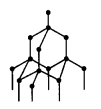
Identify the heavy metal which belongs to same group as the element discussed above.
(a) As
(b) Bi
(c) Pb
(d) Hg
Answer:
(c) The element discussed in diagram is carbon. Carbon (C) and lead (Pb) both belong to group IVA.
Question 23.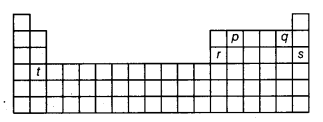
Arrange the elements, represented by alphabets p, q, r, s and t in the above shown outline of periodic table, in increasing order of their valency.
(a) t < q < r < s < p
(b) s < t < q < r < p
(c) s < q < t < r < p
(d) q < s < t < p < r
Answer:
(c) p(group IVA), q(group VIIA), r(group IILA) s(group VIII) and t(group IIA) has valency 4, 1, 3, 0 and 2 respectively hence the correct order of increasing valency is: s(0) < q(1) < t(2) < r(3) < p(4)
Question 24.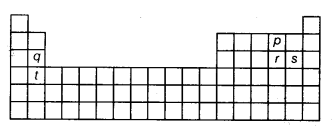
The diagram given above represents outline of the periodic table. The alphabets p, q, r, s and t represent elements. Which one of the following pairs of alphabets represents elements which consists of same number of shells in their atom?
(a) p and q
(b) r and t
(c) p and s
(d) g and s
Answer:
(d) Elements q and s belong to same period of the periodic table and hence, will have same number of shell.
NCERT Solutions for Class 10 Science Chapter 5 Periodic Classification of Elements (Hindi Medium)
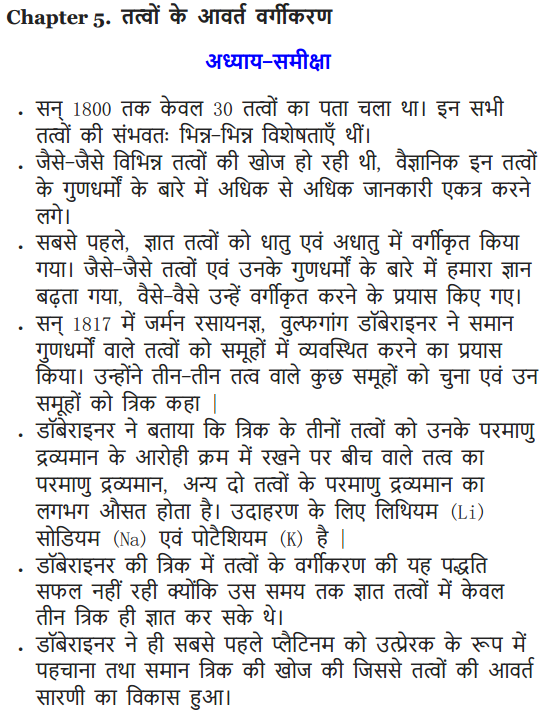
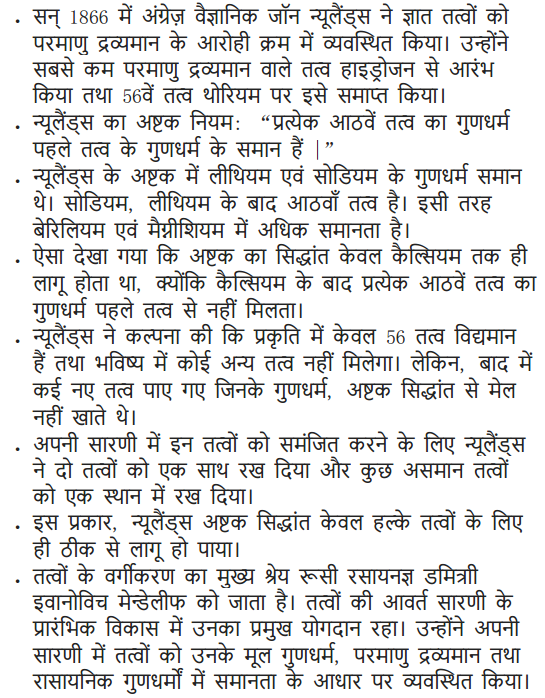
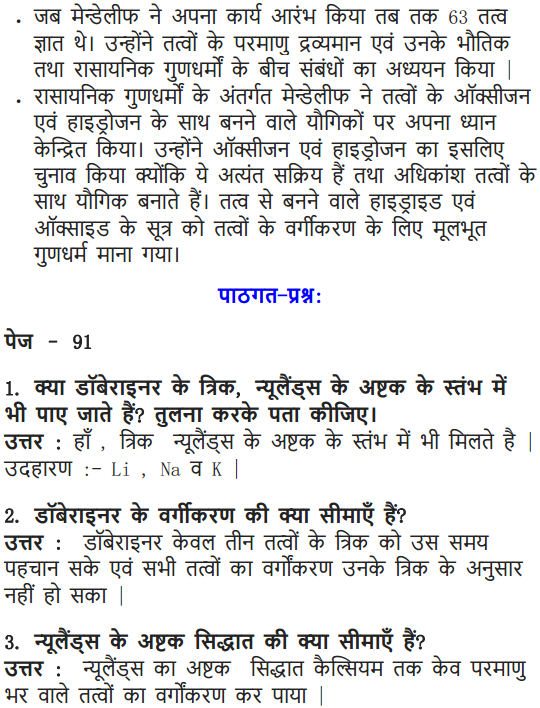
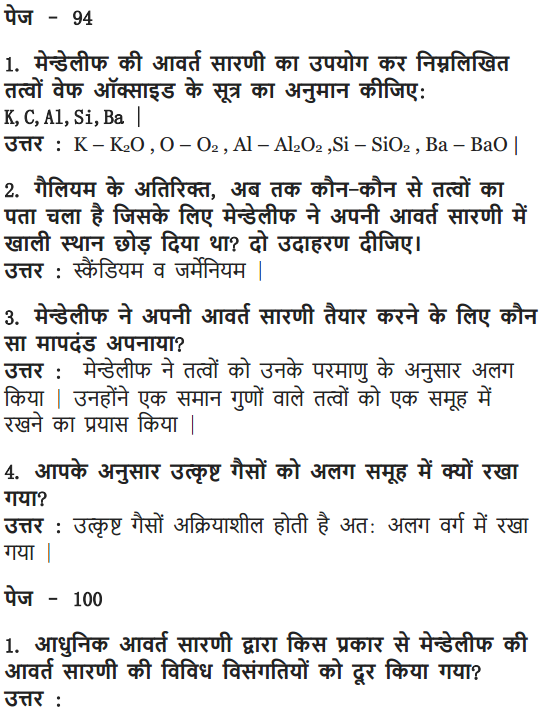
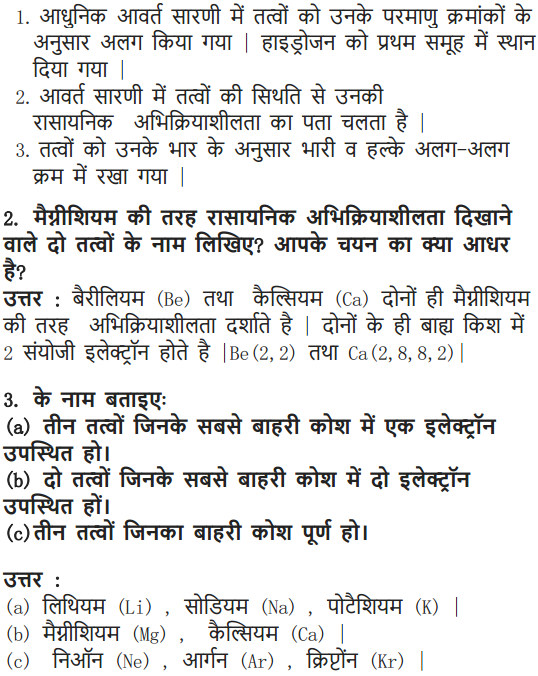
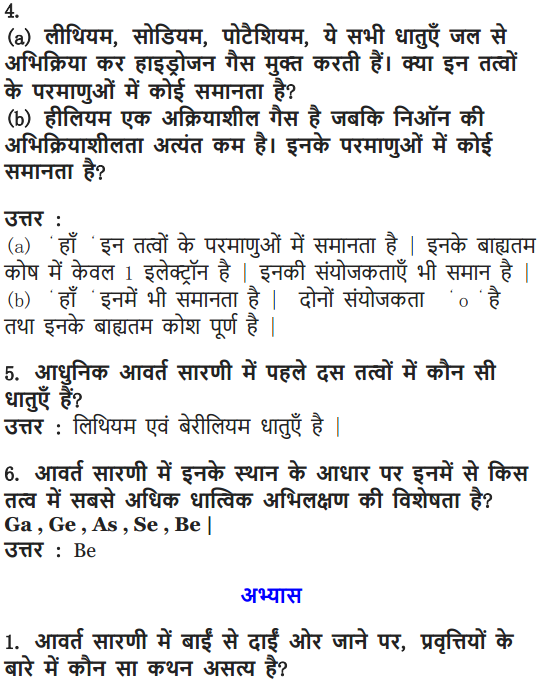
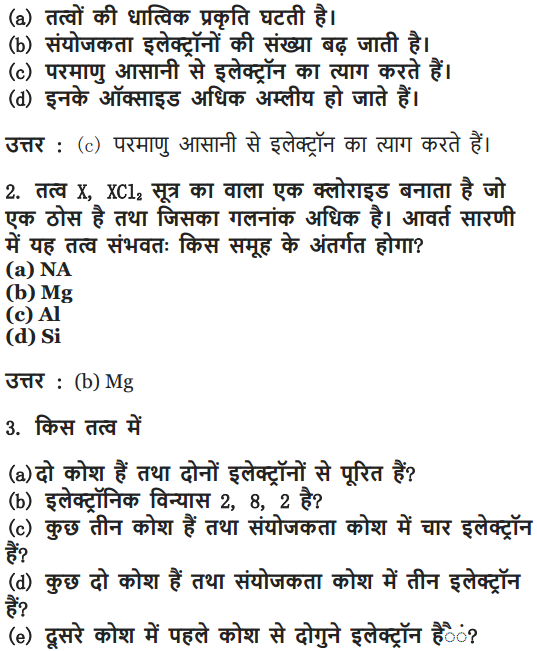
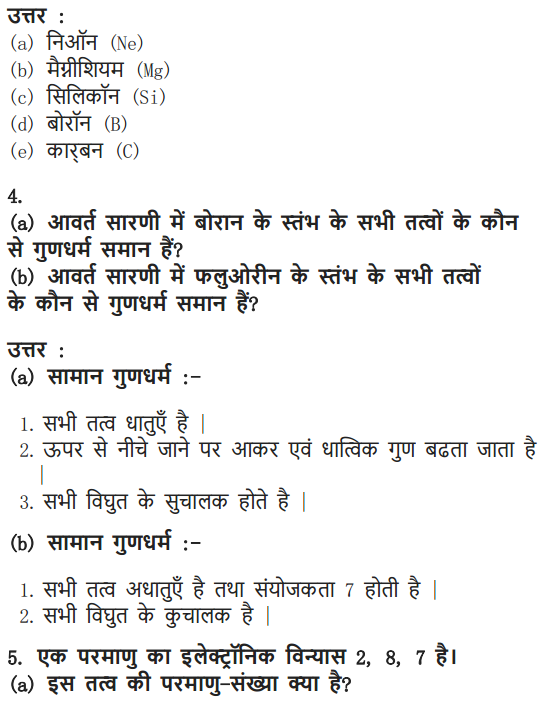
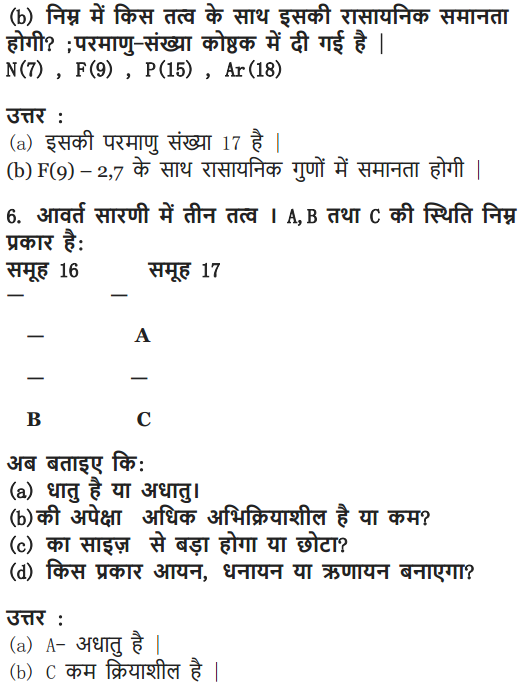
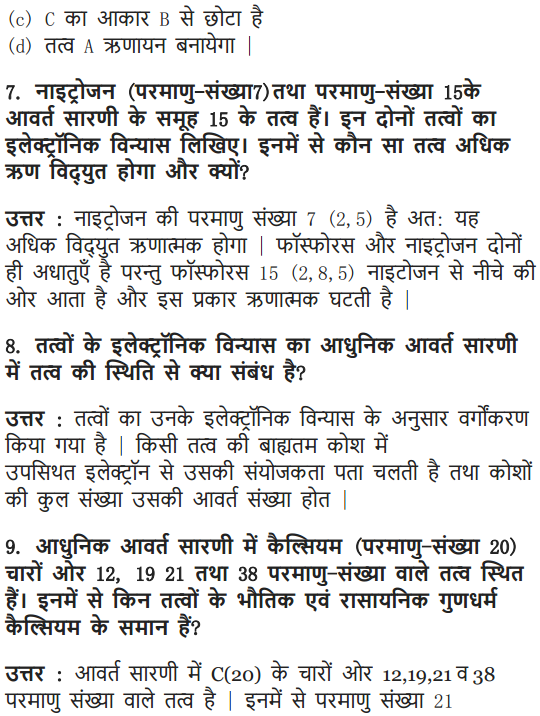
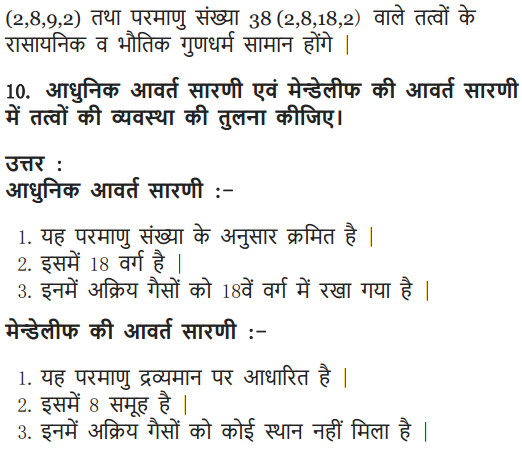
Class 10 Science Periodic Classification of Elements Mind Map
Dobereiners’s Triads
- Dobereiner found that when elements are arranged into groups of three in the order of their increasing atomic mass, the atomic mass of the element; which comes in the middle, is the arithmetic mean of rest of the two.
- He arranged three elements in one group which is known as Dobereiner’s Triads. For e.g.:
(Li) 7.0 (Na) 23.0 (K) 39.0 (Ca) 40.0 (Sr) 87.5 (Ba) 137.0 - Here atomic mass of sodium is equal to arithmetic mean of atomic masses of lihtium and potassium. Similarly, atomic mass of strontium is equal to arithmetic mean of atomic masses of calcium and barium
Limitations of Doberiner’s Triads
- He could identify only a few such triads and so the law could not gain importance.
- In the triad of Fe, Co, Ni, all the three elements have a nearly equal atomic mass and thus it does not follow the above law.
Mendeleev’s Periodic Classification
- Mendeleev periodic law, states that ‘the properties of elements are the periodic function of their atomic masses’.
- Mendeleev’s periodic table contains vertical columns called ‘groups’ and horizontal rows called ‘periods’.
Characteristics of the Mendeleev’s Periodic Table
- The elements are arranged in vertical rows called groups and horizontal rows called periods.
- There are eight groups indicated by Roman Numerals I, II, III, IV, V, VI, VII, VIII. The elements belonging to first seven groups have been divided into sub-groups designated as A and B on the basis of similarities. Group VIII consists of nine elements arranged in three triads.
- There are six periods (numbered 1,2,3,4,5 and 6).
Limitation of Mendeleev’s Periodic Table
- Some elements in Mendeleev’s Table have not been arranged in the increasing order of their atomic masses. For example, Co and Ni.
- Hydrogen forms similar compounds as Group 1 elements. However, it also forms similar diatomic molecules as Group 7 elements (H2, F2, C12, Br2, 12). Hence, it could not be assigned a fixed position in the table.
- Isotopes posed a challenge to Mendeleev’s table. For example, Cl has two major isotopes – Cl-35 and Cl-37.
Merits of Mendeleev’s Periodic Table
- Mendeleev left some blank spaces in his periodic table in order to place the elements having similar properties in the same group.
- Mendeleev predicted the discovery of some elements and named them as eka-boron, eka- aluminium and eka-silicon.
- One of the strengths of Mendeleev, s periodic table was that, when inert gases were discovered they could be placed in a new group without disturbing the existing order.
Newlands’ Law of Octaves
- According to this law “if elements are arranged by the increasing order of their atomic masses, property of every eighth element repeats.”
- The arrangement of elements in Newlands’ Octave resembles the musical notes.
Limitation of Newlands’ Octaves
- Law of Octaves could be valid up to calcium only; as after calcium, elements do not obey the rules of Octaves.
- It was assumed by Newlands that only 56 elements existed in nature and no more elements would be discovered in the future
- More than one element had to be placed in some of the groups; in order to place the elements having similar properties in one group. But in order to do so, he also put some dissimilar elements in same group.
- Iron; which has similar property as cobalt and nickel, was placed far from them.
- Cobalt and nickel were placed in the group with chlorine and fluorine in spite of having different properties.
Modern Periodic Table
In 1913, Henry Moseley showed that atomic number of an element is a more fundamental property than its atomic mass. According to this law “’properties of elements are a periodic function of their atomic number”.
Trends in Modern Periodic Table
| Property | Valency | Atomic Size | Metallic Character | Nonmetallic Character | Electronegativity |
| Variation in period | Increases from 1 to 4 then decreases to zero | Decreases | Decreases | Increases | Increases |
| Reason | No. of atomic shells remains the same & atomic number increases by 1 unit. | This is due to an increase in nuclear charge which tends to pull the electrons closer to the nucleus and reduces the size of the atom. | Effective nuclear charge increases. Hence tendency to lose electron decreases. | Effective nuclear charge increases. Hence tendency to gain electron increases | |
| Variation in group | Remains same | Increases | Increases | Decreases | Decreases |
| Reason | New shells are being added as we go down the group. This increases the distance between the outermost electrons and the nucleus so that the atomic size increases in spite of the increase in nuclear charge. | Effective nuclear charge decreases | Effective nuclear charge decreases. Hence tendency to gain electron decreases |
Position of Elements in the Modern Periodic Table
Position of Elements
| No of Valence Electrons | Group | No. of Shell | Period |
| 1 | 1 | 1 | 1 |
| 2 | 2 | 2 | 2 |
| 3 | 13 | 3 | 3 |
| 4 | 14 | 4 | 4 |
| 5 | 15 | 5 | 5 |
| 6 | 16 | 6 | 6 |
| 7 | 17 | 7 | 7 |
| 8 | 18 |
Elements are placed in groups according to the number of valence electrons and placed in periods according to the number of shells present in them.
Helium has valence electrons equal to 2, but it is placed in group number 18 because it is a noble gas and has completely filled outermost shell.
We hope the detailed information regarding NCERT Solutions For Class 10 Science Chapter 5 Periodic Classification Of Elements is helpful. For any query related to Class 10 Science Chapter 5 NCERT Solutions for Periodic Classification Of Elements, kindly drop your questions in the comment box below and we will get back to you as soon as possible.
Important Questions of Periodic Classification of Elements Class 10 Science Chapter 5
Question 1.
State Mendeleev s Periodic law.
Answer:
Medeleev’s periodic law states that the properties of elements are periodic function of their atomic masses.
Question 2.
Why did Mendeleev leave some gaps in the Periodic table?
Answer:
Mendeleev left some gaps in the periodic table for yet to be discovered elements. Mendeleev predicted the properties of these elements on the basic of their positions. For example, he predicted the properties of gallium (eka-aluminium) and germanium (eka-silicon) which were unknown at that time.
Question 3.
If the letter ‘R’ was used to represent any of the elements in the group, then the hydride and oxide of carbon would respectively be represented as
(a) RH4, RO
(b) PH4, RO2
(c) RH2, RO2
(d) RH2, RO
Answer:
(b) CH4 is written for hydride and CO2 is written for oxide of carbon.
Question 4.
Isotopes are
(a) atoms of an element with similar chemical properties but different atomic masses
(b) atoms of different elements with similar chemical properties but different atomic masses
(c) atoms of an element with different chemical properties but same atomic masses
(d) atoms of different elements with different chemical properties but same atomic masses. (2020)
Answer:
(a) Isotopes have same atomic number, hence similar chemical properties and different atomic masses.
Question 5.
How many metals are present in second period of periodic table? (2020)
Answer:
Two metals (lithium and beryllium) are present in second period of periodic table.
Question 6.
On the basis of electronic configuration of
(a) group 15 period 2
(b) group 13 period 2
(c) group 9 period 5
(d) group 13 period 5. (2020)
Answer:
(b) For element X of atomic number 5, the electronic configuration is 2,3. So, it has 3 valence electrons and hence it belongs to group 13. As five electrons are filled in two shells, so it belongs to 2nd period.
Question 7.
An element ‘X’ with atomic number 11 forms a compound with element ‘Y’ with atomic number 8. The formula of the compound formed is
(a) XY
(b) X2Y
(c) XY2
(d) X2Y3 (2020)
Answer:
(b): The electronic configuration of X is 2, 8, 1. Hence, it belongs to group 1. Its valency is 1.
The electronic configuration of Y is 2, 6. Hence, it belongs to group 16. Its valency is 2
Question 8.
Define electropositivity. (2020)
Answer:
Electropositivity is the measure of the ability of elements (mainly metals) to donate electrons to form positive ions.
Question 9.
The atomic radii of first group elements are given below:
| Group-I element | Atomic Radii (pm) |
| Na | 86 |
| K | 231 |
| Rb | 244 |
| Cs | 282 |
State the reason behind the observed trend in the above elements. (2020)
Answer:
On moving down the group, the new shells are being added. This increase the distance between outermost shell and nucleus, hence the atomic radii of elements increase gradually down the group in spite of the increase in nuclear change.
Question 10.
An element ‘X’ is forming an acidic oxide. Its position in modern periodic table will be
(a) group 1 and period 3
(b) group 2 and period 3
(c) group 13 and period 3
(d) group 16 and period 3. (2020)
Answer:
(d) : As the element X forms an acidic oxide, hence ‘X is a non-metal. Hence, X is sulphur.
Question 11.
Consider the following statements about an element ‘X with number of protons 13.
(A) It forms amphoteric oxide.
(B) Its valency is three.
(C) The formula of its chloride is XCl3.
The correct statements is/are
(a) only (A)
(b) only (B)
(c) (A) and (C)
(d) (A), (B) and (C). (2020)
Answer:
(d) The number of protons in X is 13. Hence, its atomic number is 13. The electronic configuration of X is 2, 8, 3. Hence, it is a group 13 element i.e., X is aluminium. Aluminium forms amphoteric oxide, its valency is 3 and formula of aluminium chloride is AlCl3.
Question 12.
Write the number of valence electrons present in a nitrogen atom (
Answer:
The atomic number of nitrogen is 7. Its electronic configuration is 2, 5. The number of valence electrons in it is five.
Question 13.
Write the number of vertical columns in the Modern Periodic Table. What are these columns called? (Delhi 2014, 2013)
Answer:
There are 18 vertical columns in the Modern periodic table which are called groups.
Question 14.
Write the number of horizontal rows in the Modern Periodic Table. What are these rows called? (Delhi 2014)
Answer:
There are seven horizontal rows of elements in the Modern periodic table which are known as periods.
Question 15.
Write any one difference in the electronic configurations of group 1 and group 2 elements. (Delhi 2014)
Answer:
Group 1 elements have one electron in their outermost shell while group 2 elements have two electrons in their outermost shell.
Question 16.
List any two properties of the elements belonging to the first group of the Modern Periodic Tablet (AI 2014)
Answer:
Two properties of the elements belonging to the first group:
(i) As the elements belong to group 1, so they have one electron in their outermost shell hence, valency of these elements is one.
(ii) Alkali metals (group 1 elements) are electropositive in nature.
Question 17.
Write the atomic numbers of two elements ‘X’ and ‘Y’ having electronic configurations 2, 8, 2 and 2, 8, 6 respectively. (AI 2014)
Answer:
Electronic configuration of X = 2, 8, 2
∴ Atomic number = 2+ 8 + 2 = 12 Similarly,
Electronic configuration of Y = 2, 8, 6
∴ Atomic number = 2 + 8 + 6 = 16
Question 18.
The atomic numbers of three elements A, B and C are 12, 18 and 20 respectively. State giving reason, which two elements will show similar properties. (AI 2014)
Answer:
Atomic number of A = 12
∴ Electronic configuration = 2, 8, 2
Similarly, for B(18) = 2, 8, 8
for C(20) = 2, 8, 8, 2
As elements A and C contain two valence electrons in their outermost shell (group-2) they will show similar properties.
Question 19.
State the Modern periodic law of classification of elements. (Foreign 2014)
Answer:
Modern periodic law states that the physical and chemical properties of elements are the periodic function of their atomic numbers.
Question 20.
Out of the three elements P, Q and R having atomic numbers 11, 17 and 19 respectively, which two elements will show similar properties and why? (Foreign 2014)
Answer:
Atomic number of P = 11 Electronic configuration of P = 2, 8,1 Electronic configuration of Q(17) = 2, 8, 7 and for R(19) = 2, 8, 8, 1
Thus, from electronic configurations of P and R, it is observed that they belong to group 1 as both have one valence electron and have valency equal to 1. Thus, P and R will have similar properties.
Question 21.
Write the formula used to determine the maximum number of electrons which a shell in an atom can accommodate. (Foreign 2014)
Answer:
The maximum number of electrons that can be accommodated in a shell, is given by the formula 2n², where ‘n is the number of the shell.
Question 22.
How it can be proved that the basic structure of the Modern Periodic Table is based on the electronic configuration of atoms of different elements? (Delhi 2019)
Answer:
Electronic configuration of an element decides its position in Modern periodic table.
Lets take an example of sodium (Na).
Atomic number of sodium = 11
Thus, electronic configuration of Na = 2, 8, 1 As Na contains 1 electron in its outermost shell, it belongs to group 1. Sodium contains 3 shells so, it belongs to period number 3.
Thus, we can conclude that
Group number = Number of valence electrons
(When valence electrons are 1 and 2) and group number = 10 + valence electrons
(When valence electrons are 3 and above) Period number = Number of shells in which electrons are filled.
Question 23.
The electronic configuration of an element is 2, 8, 4. State its
(a) group and period in the Modern Periodic Table.
(b) name and write its one physical property. (Delhi 2019)
Answer:
(a) The element belongs to group 14 and 3rd period of the Modern Periodic Table.
(b) The element is silicon. It is non-lustrous.
Question 24.
An element X has atomic number 13 :
(a) Write its electronic configuration.
(b) State the group to which ‘X’ belongs?
(c) Is ‘X a metal or a non-metal?
(d) Write the formula of its bromide. (Delhi 2012)
Answer:
X has atomic number = 13
(a) Electronic configuration of X = 2, 8, 3
(b) As X contains 3 valence electrons in its outermost shell, it belongs to group 13.
(c) X is a metal as it contains 3 valence electrons which can be lost easily.
(d) Formula of X with bromine will be
Question 25.
How can the valency of an element be determined if its electronic configuration is known? What will be the valency of an element of atomic number 9(nine)? (Delhi 2012, 2011)
Answer:
Valency of an element is determined by the number of electrons present in its outermost shell. For elements having outermost electrons 1 to 4, valencies are equivalent to their respective valence electrons.
For elements having outermost electrons 5 to 8, valency is calculated as;
Valency = 8 – (Number of valence electrons)
For element having atomic number = 9
Electronic configuration = 2, 7
Valency = 8 – 7 = 1
Question 26.
Choose from the following :
6C, 8O, 10Ne, 11Na, 14Si
(i) Elements that should be in the same period.
(ii) Elements that should be in the same group.
State reason for your selection in each case. (AI 2012)
Answer:
The electronic configurations of the given elements are:
6C = 2, 4
8O = 2, 6
10Ne = 2, 8
11Na = 2, 8,1
14Si = 2, 8, 4
(i) 6C, 8O, 10Ne, all contain two shells hence, they belong to same period i.e., second period.
11Na, 14Si both contain three shells hence, they belong to third period.
(6C, 8O, 10Ne) ⇒ period number 2
(11Na, 14Si) ⇒ period number 3
(ii) 6C and 14Si belong to the same group as they both contain 4 electrons in their outermost shell. Thus, 6C and 14Si belong to group 14.
Question 27.
An element ‘X’ belongs to 3rd period and group 17 of the periodic table. State its
(i) electronic configuration, (ii) valency Justify your answer with reason. (AI 2012)
Answer:
As element X belongs to group 17, it will have 7 electrons in its outermost shell. Moreover, X belongs to period number 3 so, it will have 3 shells.
(i) Electronic configuration of X = 2, 8, 7
(ii) Valency of element X
= 8 – (Number of valence electrons) = 8 – 7 = 1
Question 28.
Choose from the following :
4Be, 9F, 19K, 20Ca
(i) The element having one electron in the outermost shell.
(ii) Two elements of the same group. (Foreign 2012)
Answer:
The electronic configurations of the given elements are:
4Be = 2, 2
9F = 2, 7
19K = 2, 8, 8,1
20Ca = 2, 8, 8, 2
(i) Potassium (K) has one electron in its outermost shell.
(ii) Be and Ca have two electrons in their outermost shells hence, they belong to same group.
Question 29.
An element has atomic number 13.
(a) What is the group and period number to which this element belongs?
(b) Is this element a metal or a non-metal? Justify your answer. (Foreign 2012)
Answer:
Atomic number of element = 13
Thus, its electronic configuration = 2, 8, 3
(a) From the electronic configuration, it can be easily seen that there are 3 electrons in the outermost shell which indicates that it belongs to group number 10 + 3 = 13.
Moreover, the element has 3 shells in which electrons are filled thus, it belongs to period number 3.
(b) As the element contains 3 valence electrons which can be easily lost thus, it is a metal.
Question 30.
How does the electronic configuration of an
atom of an element relate to its position in the Modern Periodic Table? Explain with one example. (Delhi 2011)
Answer:
Refer to answer 22.
Question 31.
How does the valency of elements vary (i) in going down a group, and (ii) in going from left to right in a period of the periodic table? (AI 2011)
Answer:
(i) When we go down the group the valency of elements remains same.
(ii) When we move along the period from left to right, the valency of elements first increases and then decreases.
Question 32.
In the Modern Periodic Table, the element calcium (atomic number = 20) is surrounded by elements with atomic numbers 12, 19, 21 and 38. Which of these elements has physical and chemical properties resembling those of calcium and why? (AI 2011)
Answer:
From the given data, the electronic configuration of different elements can be written as:
Calcium (20) = 2, 8, 8, 2
Element with atomic number 12 = 2, 8, 2
Element with atomic number 19 = 2, 8, 8,1
Element with atomic number 21 = 2, 8, 8, 3
Element with atomic number 38 = 2, 8,18, 8, 2
It can be easily seen that elements with atomic numbers 12 and 38 have two electrons in their outermost shell thus, they belong to same group as that of calcium. So, they will show the physical and chemical properties resembling those of calcium.
Question 33.
In the periodic table, how does the tendency of atoms to loose electrons change on going from
(i) left to right across a period?
(ii) top to bottom in a group? (Foreign 2011)
Answer:
(i) Tendency of atoms to loose electrons decreases from left to right in a period due to increase in effective nuclear charge.
(ii) Tendency of atoms to loose electrons increases down the group due to increase in atomic radii.
Question 34.
What is meant by periodicity of properties of elements? Why are the properties of elements placed in the same group of the periodic table similar? (Foreign 2011)
Answer:
When elements are arranged in increasing order of their atomic numbers, elements with similar chemical properties are repeated at definite intervals. Ibis is known as periodicity of properties of elements.
Elements placed in the same group of the periodic table have similar properties because they have same number of outermost electrons and hence, show same valency. Thus, they all will form similar type of compounds.
Question 35.
The position of three elements A, B and C in the modern periodic table is as follows :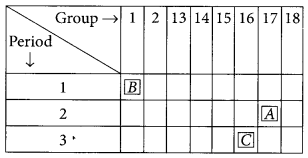
(a) Write formula of compound formed between:
(i) B and A (ii) B and C
(b) Is any of the three elements a metal? Give reason to justify your answer. (2020)
Answer:
(a) (i) B belongs to group 1, hence its valency is 1.
A belongs to group 17, hence its valency is also 1.
(ii) C belongs to group 16, hence, its valency is 2.
(b) As B belongs to group 1, it contains one valence electron which can be easily lost. Hence, B is a metal.
Question 36.
Three elements X, Y and Z have atomic numbers 7, 8 and 9 respectively.
(a) Arrange them in the decreasing order of their atomic radii.
(b) Which of the three is most electronegative? Why?
(c) Write the formula of compound formed between
(i) X and Y (ii) X and Z (2020)
Answer:
For element X of atomic number 7, the electronic configuration is 2, 5 so it has 5 valence electrons and hence, it belongs to group 15. As seven electrons are filled in two shells so, it belongs to 2nd period.
Similarly, for 7(8), electronic configuration = 2, 6
Period number = 2, Group number = 16 and for Z(9) = 2, 7
Period number = 2, Group number = 17
(a) As size of the atoms decreases on moving from left to right in a period so, the order of atomic radii will be : X > Y > Z.
(b) As electronegativity increases in moving left to right in a period so, the most electronegative element will be Z.
(c) (i) Formula of the compound when X combines with Y
(ii) Formula of the compound when X combines with Z:
Question 37.
Based on the group valency of elements write the molecular formula of the following compounds giving justification for each:
(i) Oxide of first group elements
(ii) Halide of the elements of group thirteen, and
(iii) Compound formed when an element, A of group 2 combines with an element, B of group seventeen. (Delhi 2019)
Answer:
(i) Oxides of group 1 elements :
Let the element be A.
As A belongs to group 1 of the periodic table, it will have valency = 1.
So, chemical formula of its oxide will be A O
(ii) Halides of the element of group-13 :
Let the element be D.
As D belongs to group 13, it will have valency = 3 Halide X has the valency = 1
So, chemical formula will be
(iii) Valency of A = 2
Valency of B = 1
Chemical formula of the compound will be
Question 38.
Write the names given to the vertical columns and horizontal rows in the Modern Periodic Table. How does the metallic character of elements vary on moving down a vertical column? How does the size of atomic radius vary on moving left to right in a horizontal row? Give reason in support of your answer in the above two cases. (Delhi 2017)
Answer:
In Modern periodic table, there are 18 vertical columns called groups and 7 horizontal rows called periods.
The elements which have a greater tendency to loose electrons are more metallic thus, the metallic character of elements increases down the group as their tendency to loose electrons increases. Atomic radius decreases as we move from left to right in a horizontal row. At each successive element, the electron enters to the same shell due to which there is increase in nuclear charge and the electrons are pulled with greater attractive force. Hence, the atomic size decreases.
Question 39.
An element P (atomic number 20) reacts with an element Q (atomic number 17) to form a compound. Answer the following question giving reason:
Write the position of P and Q in the Modern Periodic Table and the molecular formula of the compound formed when P reacts with Q. (Delhi 2017)
Answer:
Atomic number of P = 20
∴ Electronic configuration of P = 2, 8, 8, 2
Atomic number of Q = 17
∴ Electronic configuration of Q = 2, 8, 7 As P contains 4 shells, it belongs to 4th period and due to presence of two valence electrons, it belongs to 2nd group.
Similarly, Q contains 3 shells and 7 valence electrons thus, it belongs to 3rd period and 17th (10 + 7) group.
The molecular formula of compound formed when P reacts with Q will be :
Question 40.
Write the number of periods and groups in the Modern Periodic Table. How does the metallic character of elements vary on moving (i) from left to right in a period, and
(ii) down a group? Give reason to justify your answer. (AI 2017)
Answer:
In the Modern periodic table, there are 18 vertical columns called groups and 7 horizontal rows called periods.
Trend of metallic character :
(i) Along the period from left to right: Metallic character of elements decreases as we move from left to right in a period. Metallic character depends on the electropositive character (tendency to loose electrons) of the elements. As we go across the period from left to right, one electron is added to same shell at every stage which increases the effective nuclear charge and hence, valence electrons becomes more and more closer to the nucleus. Due to this, the tendency of atoms to loose valence electrons and form positive ions decreases. Hence, electropositive character decreases resulting in decrease of metallic character.
(ii) Down the group : Metallic character of elements increases on moving down the group as the electropositive character increases down the group.
Question 41.
Na, Mg and Al are the elements of the 3rd periods of the Modern Periodic Table having group number 1,2 and 13 respectively. Which one of these elements has the
(a) highest valency, (b) largest atomic radius, and (c) maximum chemical reactivity? Justify your answer stating the reason for each. (AI 2017)
Answer:
Period number of Na, Mg and Al = 3
Group numbers of Na, Mg and Al are 1, 2 and 13 respectively.
(a) Aluminium (Al) will show highest valency of +3 as it belongs to group number 13 (valency = 13 – 10 = 3). Moreover, along the period from left to right valency first increases to maximum (+4) and then decreases.
(b) Sodium (Na) will have the largest atomic radius because as we move along the period from left to right, the atomic radius decreases.
(c) Sodium (Na) will have maximum chemical reactivity because as we move along the period from left to right, chemical reactivity of metals decreases.
Question 42.
Calcium is an element with atomic number 20. Stating reason answer each of the following questions:
(i) Is calcium a metal or non-metal?
(ii) Will its atomic radius be larger or smaller than that of potassium with atomic number 19?
(iii) Write the formula of its oxide. (Delhi 2016)
Answer:
Given that, atomic number of calcium is 20.
So, its electronic configuration = 2, 8, 8, 2 .
(i) As, it has 2 valence electrons in the outermost shell which can be easily lost, so it is a metal.
(ii) Atomic number of K (potassium) is 19 so, it is placed before Ca(20) in the same period.
On moving from left to right in a period, the atomic radius decreases.
Hence, atomic radius of Ca(20) will be smaller than that of K(19).
(iii) The valency of calcium as well as oxygen is 2 thus, the formula of the oxide will be CaO.
Question 43.
An element M with electronic configuration (2, 8, 2) combines separately with (NO
Answer:
Electronic configuration of M is 2, 8, 2 which shows that it belongs to group 2 and period 3 of the Modern periodic table.
As it has 2 valence electrons, so the valency of element M will be 2.
The chemical formulae of the compounds formed will be
M(NO3)2,MSO4, M3(PO4)2
As M has two valence electrons, it can easily loose these electrons to attain a noble gas configuration. Hence, M will form ionic compounds.
Question 44.
Name any two elements of group one and write their electronic configurations. What similarity do you observe in their electronic configurations? Write the formula of oxide of any of the aforesaid element. (Delhi 2016)
Answer:
Two elements of group 1 are sodium (Na) and potassium (K).
Electronic configuration of Na (11) = 2, 8, 1
Electronic configuration of K (19) = 2, 8, 8, 1
From the electronic configuration, we observe that both (Na and K) have one electron in outermost shell due to which they have valency equal to one.
Thus, formula of their oxides are, Na2O and K2O.
Question 45.
Two elements A and B belong to the 3rd period of Modern Periodic Table and are in group 2 and 13 respectively. Compare their following characteristics in tabular form.
(a) Number of electrons in their atoms
(b) Size of their atoms
(c) Their tendencies to loose electrons
(d) The formula of their oxides
(e) Their metallic characters
(f) The formula of their chlorides (Delhi 2016)
Answer:
Electronic configuration of A = 2, 8, 2 i.e., Mg
Electronic configuration of B = 2, 8, 3 i.e., Al
| Characteristics | A | B |
| (a) No. of electrons in their atoms | 12 | 13 |
| (b) Size of their atoms | Bigger | Smaller |
| (c) Tendency to loose electrons | More | Less |
| (d) Formula of their oxides | AO | B2O3 |
| (e) Metallic character | More | Less |
| (f) Formula of their chlorides | ACl2 | BCl2 |
Question 46.
An element ‘X’ belongs to 3rd period and group 16 of the Modern Periodic Table.
(a) Determine the number of valence electrons and the valency of ‘X
(b) Molecular formula of the compound when ‘X’ reacts with hydrogen and write its electron dot structure.
(c) Name the element ‘X’ and state whether it is metallic or non-metallic. (AI 2016)
Answer:
(a) As the element ‘X’ belongs to 3rd period so, it will have three energy shells. Moreover, it belongs to 16th group, so it will have six valence electrons.
∴ Electronic configuration of X = 2, 8, 6
Thus, valence electrons = 6 and valency = 8 – 6 = 2
(b) Molecular formula of the compound formed when X reacts with hydrogen = H2X The electron dot structure is as :
(c) The element X is sulphur and it is a non-metal.
Question 47.
An element ‘X’ has mass number 35 and number of neutrons 18. Write atomic number and electronic configuration of ‘X’ Also write group number, period number and valency of X. (AI 2016)
Answer:
Mass number of X = 35
Number of neutrons = 18
∴ Number of electrons = Number of protons – (Mass number – Number of neutrons)
= 35 – 18 = 17
Number of electrons of X = Atomic number of X= 17
Thus, electronic configuration of X = 2, 8, 7 As it has 7 electrons in the outermost shell, so it belongs to 17th group. Moreover the electrons are present in three shells, so it belongs to 3rd period. Valency of X = 8 – 7 = 1
Question 48.
Three elements ‘X\ ‘Y’ and ‘Z’ have atomic numbers 7, 8 and 9 respectively.
(a) State their positions (group number and period number both) in the Modern Periodic Table.
(b) Arrange these elements in the decreasing order of their atomic radii.
(c) Write the formula of the compound formed when X’ combines with ‘Z’. (AI 2016)
Answer:
(a) For element X of atomic number 7, the electronic configuration is 2, 5 so it has 5 valence electrons and hence, it belongs to group 15. As seven electrons are filled in two shells so, it belongs to 2nd period.
Similarly, for Y(8), electronic configuration = 2, 6
Period number = 2, Group number = 16 and for Z(9) = 2, 7
Period number = 2, Group number = 17
(b) As size of the atoms decreases on moving from left to right in a period so, the order of atomic radii will be : X > Y > Z
(c) Formula of the compound when X combines with Z:
Question 49.
The position of eight elements in the Modern Periodic Table is given below where atomic numbers of elements are given in the parenthesis.
| Period No | ||
| 2 | Li (3) | Be (4) |
| 3 | Na (11) | Mg (12) |
| 4 | K (19) | Ca (20) |
| 5 | Rb (37) | Sr (38) |
Write the electronic configuration of Ca.
(ii) Predict the number of valence electrons in Rb.
(iii) What is the number of shells in Sr?
(iv) Predict whether K is a metal or a non-metal?
(v) Which one of these elements has the largest atom in size?
(vi) Arrange Be, Ca, Mg and Rb in the increasing order of the size of their respective atoms. (AI 2016)
Answer:
(i) Atomic number of Ca = 20
∴ Electronic configuration = 2, 8, 8, 2
(ii) Rb (37), electronic configuration = 2, 8, 18, 8, 1
Thus, number of valence electrons = 1
(iii) As Sr (38) belongs to period number 5 so, it will have 5 shells.
(iv) As K(19) = 2, 8, 8, 1
s0, it has 1 valence electron which can be easily lost to attain the noble gas configuration. Hence, potassium (K) is a metal.
(v) Size of the atom increases down the group and decreases from left to right along a period. Thus, Rb (37) will be the largest atom among given elements.
(vi) Increasing order of atomic size is Be < Mg < Ca < Rb
Question 50.
An element ‘X’ belongs to 3rd period and group 13 of the Modern Periodic Table.
(a) Determine the valence electrons and the valency of ‘X’.
(b) Molecular formula of the compound formed when ‘X’ reacts with an element ‘Y’ (atomic number = 8)
(c) Write the name and formula of the compound formed when ‘X’ combines with chlorine. (AI 2016)
Answer:
(a) As X belongs to group 13 so, it will have three valence electrons and valency of X will be 3.
(b) Atomic number of Y = 8
∴ Electronic configuration = 2, 6
Valency of Y = 8 – 6 = 2
Molecular formula of the compound when X reacts with element Y:
(c) As X belongs to 3rd period and group number 13, so it will be aluminium (Al).
For chlorine (17), electronic configuration = 2,8,7
∴ Valency of Cl = 8 – 7 = 1
∴ Formula of the compound :
Question 51.
State the main aim of classifying elements. Which is the more fundamental property of elements that is used in the development of Modern Periodic Table? Name and state the law based on this fundamental property. On which side of the periodic table one can find metals, non-metals and metalloids? (Foreign 2016)
Answer:
The main aim of classifying elements is the prediction of their properties with more precision (systematic study of known elements).
When the elements are arranged on the basis of increasing atomic number then it is easier to predict their properties. This led to the development of Modern periodic table. Modern periodic law states that the properties of elements are periodic function of their atomic numbers.
In Modern periodic table, the metals like sodium and magnesium are towards left hand side while the non-metals like sulphur and chlorine are found on the right hand side. Elements like silicon, germanium, etc. which lie along the border line (group 13 to group 16) are semi-metals or metalloids because they exhibit some properties of both metals and non-metals.
Question 52.
An element ‘X’ (atomic number 20) burns in the presence of oxygen to form a basic oxide.
(a) Identify the element and write its electronic configuration.
(b) State its group number and period number in the Modern Periodic Table.
(c) Write a balanced chemical equation for the reaction when this oxide is dissolved in water. (Foreign 2016)
Answer:
(a) Atomic number of element X is 20 so, it is calcium (Ca).
Electronic configuration of Ca = 2, 8, 8, 2
(b) As calcium has two valence electrons in its outermost shell, so it belongs to group 2.
Moreover, it has four shells which indicates that it belongs to period number 4.
(c) Calcium forms a basic oxide having the formula:
When calcium oxide is treated with water then calcium hydroxide is formed.![]()
Question 53.
An element ‘X’ belongs to third period and second group of the Modern Periodic Table.
(a) Write its electronic configuration.
(b) Is it a metal or non-metal? Why?
(c) Write the formula of the compound formed when ‘X’ reacts with an element
(i) Y of electronic configuration 2, 6 and
(ii) Z of electronic configuration 2, 8, 7. (Foreign 2016)
Answer:
Third period indicates that it has three shells while group 2 indicates that it has two valence electrons in its outermost shell.
Thus, X must be magnesium (Mg).
(a) Electronic configuration = 2, 8, 2
(b) As X has two valence electrons in its outermost shell which can be easily lost to form a noble gas configuration, so it is a metal.
(c) (i) Electronic configuration of Y = 2, 6 Hence, valency of Y = 8 – 6 = 2
Formula of compound formed when X reacts with Y is
(ii) Electronic configuration of Z = 2, 8, 7
Hence, valency of Z = 8 – 7 = l
Formula of compound formed when X reacts with Z is
Question 54.
The atomic number of an element X is 19.
(a) Write its electronic configuration.
(b) To which period of the Modern Periodic Table does it belong and what is its valency?
(c) If ‘X’ burns in oxygen to form its oxide, what will be its nature – acidic, basic or neutral?
Write balanced chemical equation for the reaction when this oxide is dissolved in water. (Foreign 2016)
Answer:
Atomic number of X = 19
(a) Electronic configuration of X = 2, 8, 8,1
(b) X has four shells so, the period number of X = 4. Moreover, it has one electron in its outermost shell, so the valency of X will be equal to one.
(c) Electronic configuration of X shows that it is a metal and metals form basic oxides.
(d) When oxide of X is dissolved in water then its hydroxide will be formed.
X2O + H2O → 2XOH
Question 55.
How does the tendency of the elements to loose electrons change in the Modern Periodic Table in (i) a group, (ii) a period and why? (Foreign 2016)
Answer:
(i) Tendency of the elements to loose electrons increases down the group. The reason being that at each succeeding element down a group, the number of shells increases. So, the distance of the valence shell from the nucleus increases due to which the effective nuclear charge decreases on the last shell of electrons. So, it becomes easier for the atom to loose electrons.
(ii) Tendency of the elements to loose electrons decreases in a period from left to right. The reason being that as the electron enters to the same shell at each successive element the effective nuclear charge on the valence shell electron increases, the attraction between the valence electrons and nucleus increases so, it becomes difficult to loose electrons.
Question 56.
How many groups and periods are there in the Modern Periodic Table? How do the atomic size and metallic character of elements vary as we move:
(a) down a group and
(b) from left to right in a period? (Delhi 2015)
Answer:
There are 18 groups and 7 periods in the Modern periodic table.
Atomic size increases down the group, while moving from left to right in a period it decreases.
Metallic character of elements increases down the group while moving from left to right in a period it decreases.
Question 57.
Na, Mg and A1 are the elements of the same period of Modern Periodic Table having one, two and three valence electrons respectively. Which of these elements (i) has the largest atomic radius, (ii) is least reactive? Justify your answer stating reason for each case. (Delhi 2015, AI 2012)
Answer:
Na, Mg and A1 belong to same period of Modern periodic table.![]()
(i) Sodium (Na) will have the largest atomic radius because as we move from left to right in a period, atomic size decreases due to increase in effective nuclear charge which pulls the outermost electrons more closer to the nucleus.
(ii) Aluminium (Al) is least reactive because on moving from left to right in the periodic table the nuclear charge increases, so the valence electrons are pulled more closer to the nucleus. Therefore, the tendency to loose electrons decreases and hence, reactivity decreases.
Question 58.
From the following elements :
4Be; 9F; 19K; 20Ca
(i) Select the element having one electron in the outermost shell.
(ii) Two elements of the same group.
Write the formula and mention the nature of the compound formed by the union of 19K and element X (2, 8, 7). (Delhi 2015)
Answer:
Refer to answer 28.
The, formula of compound when K combines with X is
As K has one electron in its outermost shell, so it transfers this electron to outermost shell of X and hence, an ionic compound is formed.![]()
Question 59.
Write the number of periods the Modern Periodic Table has. State the changes in valency and metallic character of elements as we move from left to right in a period. Also state the changes, if any, in the valency and atomic size of elements as we move down a group. (Delhi 2015, 2013)
Answer:
There are 7 periods in the Modern periodic table.
As we move along the period from left lo right then valency of the elements first increases from 1 to 4 and then decreases to 0.
On moving from left to right in a period the metallic character of elements decreases as the electropositive character of elements decreases across the period.
On moving down the group, the valency of the elements remains the same while atomic size increases. This is due to addition of new shell of electrons at every successive step.
Question 60.
Two elements ‘P’ and ‘Q’ belong to the same period of the Modern Periodic Table and are in Group-1 and Group-2 respectively. Compare their following characteristics in tabular form:
(a) The number of electrons in their atoms.
(b) The sizes of their atoms.
(c) Their metallic character.
(d) Their tendencies to loose electrons.
(e) The formula of their oxides.
(f) The formula of their chlorides. (AI 2015)
Answer:
The given characteristics can be tabulated as follows: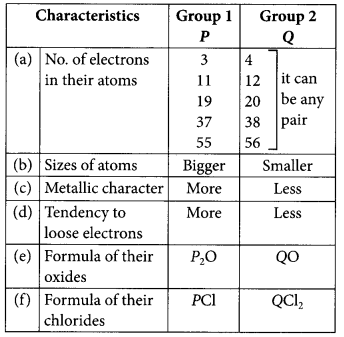
Question 61.
Taking the example of an element of atomic number 16, explain how the electronic configuration of the atom of an element relates to its position in the Modern Periodic Table and how valency of an element is calculated on the basis of its atomic number. (AI 2015)
Answer:
Atomic number of the element = 16
Thus, electronic configuration = 2, 8, 6
Since, this element contains 3 shells hence, it belongs to period number 3.
As the element has 6 valence electrons, group number = 10 + 6 = 16
The valency of an element is determined by the number of electrons present in the outermost shell.
∴ Valency of the element = 8 – valence electrons
= 8 – 6 = 2
Question 62.
Given below are some elements of the Modern Periodic Table. Atomic number of the element is given in the parentheses : A(4),B(9),C(14),D(19),£(20)
(a) Select the element that has one electron in the outermost shell. Also write the electronic configuration of this element.
(b) Which two elements amongst these belong to the same group? Give reason for your answer.
(c) Which two elements amongst these belong to the same period? Which one of the two has bigger atomic radius? (AI 2015)
Answer:
The electronic configuration of the given elements will be as follows :
A(4) = 2, 2
B(9) = 2, 7
C(14) = 2, 8,4
D(19) = 2, 8, 8,1
E(20) = 2, 8, 8, 2
(a) Element D will have one electron in its outermost shell.
(b) Elements A and E will belong to same group as both of them have same electrons in their outermost shells.
(c) A and B belong to period number 2 (two shells). A has bigger atomic radius than B.
D and E belong to period number 4 (four shells). D has bigger atomic radius than E.
Question 63.
The atomic number of an element ‘X’ is 20.
(i) Determine the position of the element X in the periodic table.
(ii) Write the formula of the compound formed when ‘X’) reacts/combines with another elements ‘Y’ (atomic number 8).
(iii) What would be the nature (acidic or basic) of the compound formed? Justify your answer. (Foreign 2015)
Answer:
Refer to answer 52.
Question 64.
An element X is placed in the 3rd group and 3rd period of the Modern Periodic Table. Answer the following questions stating reason for your answer in each case :
(a) Write the electronic configuration of the element X.
(b) Write the formula of the compound formed when the element X reacts with another element ‘Y’ of atomic number 17.
(c) Will the oxide of this element be acidic or basic? (Foreign 2015)
Answer:
X is placed in 3rd group (IIIA) and 3rd period of the Modern periodic table then it must be aluminium (Al).
As it belongs to 3rd group so it will have 3 electrons in its outermost shell.
Also it belongs to 3rd period, so it will have 3 shells.
(a) Electronic configuration of X = 2, 8, 3
(b) Atomic number of Y = 17
Electronic configuration = 2, 8, 7
Valency of V = 8 – 7 = 1
Formula of compound formed when X reacts with Y:
(c) Al2O3 is amphoteric in nature i.e., acidic as well as basic oxide.
Question 65.
Four elements P, Q, R and S belong to the third period of the Modern Periodic Table and have respectively 1, 3, 5 and 7 electrons in their outermost shells. Write the electronic configurations of Q and R and determine their valencies. Write the molecular formula of the compound formed when P and S combine. (Foreign 2015)
Answer:
P, Q, R and S all belong to 3rd period so, all of them will have 3 shells and the number of electrons in their outermost shell is 1, 3,5 and 7 respectively.
∴ Electronic configuration of Q = 2, 8, 3 and its valency = 3
Similarly, electronic configuration of R = 2, 8, 5
and its valency = 8 – 5 = 3
Electronic configuration of P = 2, 8, 1
Thus, valepcy of P = 1
Electronic configuration of S = 2, 8, 7
Thus, valency of S = 8 – 7 = 1
Molecular formula of the compound :
Question 66.
In the following table, the positions of six elements A, B, C, D, E and F are given as they are in the Modern Periodic Table :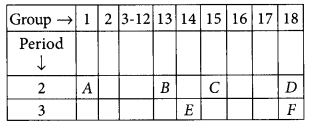
On the basis of the above table, answer the following questions:
(i) Name the element which forms only covalent compounds.
(ii) Name the element which is a metal with valency three.
(iii) Name the element which is a non-metal with valency three.
(iv) Out of B and C, whose atomic radius is bigger and why?
(v) Write the cbmmon name for the family to which the elements D and F belong. (Foreign 2015)
Answer:
(i) Element E will form only covalent compounds because it has 4 electrons in the outermost shell so, it can neither loose nor gain 4 electrons, hence E forms compounds by sharing of electrons.
(ii) Element E is a metal having valency 3 as it belongs to group 13.
(iii) C is a non-metal with valency (8 – 5 = 3).
(iv) Out of B and C, B will be bigger in size because as we move along the period from left to right, the atomic radius decreases due to addition of electrons in the same shell at each successive element. Hence, nucleus pulls electrons more towards the centre.
(v) D and E belong to group 18 and are called noble gases.
Question 67.
Based on the group valency of elements state the formula for the following giving justification for each:
(i) Oxides of 1st group elements,
(ii) Halides of the elements of group-13, and
(iii) Compounds formed when an element of group-2 combines with an element of group-16. (Delhi 2014)
Answer:
(i) Refer to answer 37(i).
(ii) Refer to answer 37(ii).
(iii) Compounds formed when element of group-2 combines with an element of group-16 :
Let the group-2 element be X and group-16 element be Y.
Valency of X = 2
Valency of Y = 2
Chemical formula of the compound will be
Question 68.
(a) Define the following terms :
(i) Valency; (ii) Atomic size
(b) How do the valency and the atomic size of the elements vary while going from left to right along a period in the Modern Periodic Table? (Delhi 2014)
Answer:
(a) (i) Valency: It is defined as the combining capacity of the element which is determined by the number of valence electrons present in the outermost shell of its atom.
(ii) Atomic size : It is defined as the distance between the centre of the nucleus and the outermost shell of an isolated atom.
(b) On moving from left to right in the period, the valency of elements increases from 1 to 4 and then decreases to 0.
This is because the elements in a period do not have the same number of valence electrons hence, they do not show same valency.
The atomic size decreases on moving from left to right along a period due to increase in nuclear charge which tends to pull the electrons closer to the nucleus and reduces the size of the atom.
Question 69.
Consider two elements X (atomic number 17) and Y (atomic number 20).
(i) Write the positions of these elements in the Modern Periodic Table giving justification.
(ii) Write the formula of the compound formed by the combination of X and Y.
(iii) Draw the electron-dot structure of the compound formed and state the nature of the bond formed between the two elements. (Delhi 2014)
Answer:
Atomic number of X = 17
Electronic configuration of X = 2, 8, 7
Atomic number of Y = 20
Electronic configuration of Y = 2, 8, 8, 2
(i) From the electronic configurations, we can easily observe that X contains 3 shells so, it belongs to period 3 and it contains 7 electrons in the outermost shell so, it belongs to group-17. Similarly for Y, it has 4 shells which implies that it belongs to period 4 and Y contains two electrons in the outermost shell so, it belongs to group-2.
(ii) Valency of X = 1
Valency of Y = 2
Thus, formula of the compound formed will be
(iii) Electron dot structure of the compound will be
As two electrons present in the outermost shell of Y are donated to two different atoms of X thus, it will be an ionic bond (formed by the complete transfer of electrons).
Question 70.
Consider two elements ‘A’ (Atomic number 17) and ‘B’ (Atomic number 19).
(i) Write the positions of these elements in the Modern Periodic Table giving justification.
(ii) Write the formula of the compound formed when ‘A’ combines with ‘B’.
(iii) Draw the electron dot structure of the compound and state the nature of the bond formed between the two elements. (Delhi 2014)
Answer:
Atomic number of A = 17
Electronic configuration of A = 2, 8, 7
Atomic number of B = 19
Electronic configuration of B = 2, 8, 8, 1
(i) From the electronic configuration of A, it can be easily observed that A contains three shells which indicates that it belongs to period 3. Moreover, it has seven valence electrons in its outermost shell which indicates that it belongs to group 17.
Similarly for B, it has 4 shells so, it belongs to period 4 and it has one electron in outermost shell so, it belongs to group 1.
(ii) The molecular formula of the compound when A combines with B will be
As A contains 7 electrons in the outermost shell so, it is an electropegative element that is why A is placed after B.
(iii) The electron dot structure will be![]()
The one electron present in the outermost shell of B gets transferred to the outermost shell of A and hence, ionic bond is formed.
Question 71.
The electrons in the atoms of four elements A, B, C and D are distributed in the three shells having 1, 3, 5 and 7 electrons in the outermost shell respectively. State the period in which these elements can be placed in the Modern Periodic Table. Write the electronic configuration of the atoms of A and D and the molecular formula of the compound formed when A and D combine. (AI 2014)
Answer:
Refer to answer 65.
Question 72.
Study the following table in which positions of six elements A, B, C, D, E and F are shown as they are in the Modern Periodic Table :
On the basis of the above table, answer the following questions: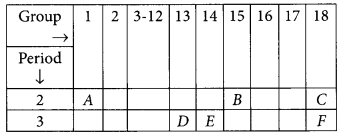
(i) Name the element which forms only covalent compounds.
(ii) Name the element which is a metal with valency three.
(iii) Name the element which is a non-metal with valency three.
(iv) Out of D and E, which is bigger in size and why?
(v) Write the common name for the family to which the elements C and F belong. (AI 2014)
Answer:
(i) Element E will form only covalent compounds because it has 4 electrons in the outermost shell so, it can neither loose nor gain 4 electrons, hence E forms compounds by sharing of electrons.
(ii) Element D is a metal having valency 3 as it belongs to group 13.
(iii) B is a non-metal with valency (8 – 5 = 3).
(iv) Out of D and E, D will be bigger in size because as we move from left to right in a period there is addition of extra electron in the same shell due to which electrons are pulled more closer to the nucleus.
(v) C and F belong to group 18 and are called noble gases.
Question 73.
What is meant by ‘group’ in the Modern Periodic Table? How do the following change on moving from top to bottom in a group?
(i) Number of valence electrons.
(ii) Number of occupied shells.
(iii) Size of atoms.
(iv) Metallic character of elements.
(v) Effective nuclear charge experienced by valence electrons. (AI 2014)
Answer:
The vertical columns in the Modern periodic table are called groups. There are total 18 groups in the Modern periodic table.
(i) In a particular group, the number of valence electrons remains the same.
(ii) On moving down the group, there is addition of an extra shell successively. Flence, number of occupied shells increases.
(iii) Due to addition of extra shells down the group, the size of the atoms i.e.. the distance between nucleus and the outermost shell also increases.
(iv) Down the group as atomic size increases, the outermost electron is pulled by nucleus to lesser extent and lienee, tendency to loose electrons increases i.e., metallic character increases.
(v) Effective nuclear charge experienced by valence electrons decreases down the group due to increase in size of atoms.
Question 74.
The elements Be, Mg and Ca each having two electrons in their outermost shells are in periods 2, 3 and 4 respectively of the Modern Periodic Table. Answer the following questions, giving justification in each case:
(i) Write the group to which these elements belong.
(ii) Name the least reactive element.
(iii) Name the element having largest atomic radius. (AI 2014)
Answer:
(i) As Be, Mg and Ca have two electrons in their outermost shell so, they all belong to group 2.
(ii) Be will be least reactive element, as down the group the reactivity of the metals increases. Be being smaller in size as compared to others will have less tendency to loose electrons and hence, is less reactive.
(iii) As we move down the group, atomic radius increases hence, calcium will have the largest atomic radius.
Question 75.
What are groups and periods in the periodic table? Two elements X and Y belong to group 1 and 2 respectively and are in the same period of the periodic table. How do the following properties of X and Y vary?
(i) Size of their atoms.
(ii) Their metallic character.
(iii) Their valencies in forming oxides.
(iv) Molecular formula of their chlorides. (Foreign 2014)
Answer:
The horizontal rows of elements in the periodic table are called periods. There are seven periods in the long form of periodic table.
The vertical columns in a periodic table are called groups. There are 18 groups in the long form of periodic table.
X belongs to group-1 while Y belongs to group-2 of the same period hence, valency of X will be 1 and valency of Y will be 2.
(i) As we move along the period from left to right the size of the atoms decreases. Hence, X will be bigger than Y.
(ii) Across the period from left to right, the metallic character decreases. Hence, X is more metallic than Y.
(iii) The valency of X in its oxide will be 1 and that of Y in its oxide will be 2.
(iv) Molecular formula of their chlorides will be
Question 76.
Write the number of groups and periods in the Modern Periodic Table. Mention the criteria of placing elements in the (i) same group and (ii) same period. Illustrate your answer with an example for each case. (Foreign 2014, Delhi 2013C)
Answer:
There are 18 groups and 7 periods in the Modern periodic table.
(i) For elements to be in the same group, they should have same number of electrons in their outermost shells. For example, sodium and potassium have one electron in their outermost shells, so they belong to same group i.e., group 1.
(ii) For elements to be in the same period, they should have same number of shells. For example, magnesium (12) and aluminium (13) contain three shells so, they belong to period 3.
Question 77.
Study the following table in which positions of six elements A, B, C, D, E and F are shown as they are in the Modern Periodic Table :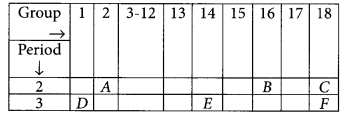
On the basis of the above table, answer the following questions:
(i) Name the element which will form only covalent compounds.
(ii) Which element is a metal with valency one?
(iii) Which element is a non-metal with valency two?
(iv) Out of D and E, which has a bigger atomic radius and why?
(v) Write the formula of the compound formed when B combines with D.
Answer:
(i) Element E will form only covalent compounds.
(ii) Element D is a metal with valency one as it belongs to group 1.
(iii) Element B is a non-metal with valency 2 as it belongs to group 16 (valency = 8-6 = 2).
(iv) Out of D and E, D will have bigger atomic radius because as we move along the period from left to right there is decrease in atomic radius.
(v) Valency of B = 2 Valency of D = 1
Question 78.
The electronic configuration of an element is 2, 8, 8, 1.
(i) State its group number and period number in the Modern Periodic Table.
(ii) State whether this element is a metal or a non-metal.
Give reason for the justification of your answer in each case. (Foreign 2014)
Answer:
Electronic configuration of element = 2, 8, 8, 1
(i) It contains one electron in its outermost shell thus, it belongs to group 1. Moreover, the element has 4 shells, so it belongs to period 4.
(ii) As the element contains one electron in its outermost shell which can be easily lost hence, it acts as a metal.
Question 79.
Given below are some elements of the Modern Periodic Table:
4Be, 9F, 14Si, 19K, 20Ca
(i) Select the element that has one electron in the outermost shell and write its electronic configuration.
(ii) Select two elements that belong to the same group. Give reasons for your answer.
(iii) Select two elements that belong to the same period. Which one of the two has bigger atomic size? (Delhi 2013)
Answer:
(i), (ii) Refer to answer 28.
(iii) Be and F belong to the same period (period 2). K and Ca belong to the same period (period 4). Among Be and F, Be will be bigger in size and among K and Ca, K will be bigger in size.
Question 80.
An element ‘X’ belongs to the third period and group one of the Modern Periodic Table. Find (i) the number of its valence electrons (ii) its valency, and (iii) whether X is a metal or a non-metal. State reasons to justify your answer in each case. (Delhi 2013C)
Answer:
As element X belongs to group 1, thus it will have one electron in its outermost shell. Moreover, it belongs to period 3 which implies that X has 3 shells.
(i) Electronic configuration of X will be 2, 8,1 Hence, number of valence electrons = 1
(ii) Valency of X will be 1.
(iii) As X contains 1 valence electron which can be easily lost hence, it is a metal.
Question 81.
F, Cl and Br are the elements each having seven valence electrons. Which of these (i) has the largest atomic radius, (ii) is most reactive? Justify your answer stating reason for each. (Delhi 2012)
Answer:
(i) F, Cl and Br all have seven valence electrons so, they belong to the same group. On moving down the group, the atomic size of the elements increases due to addition of extra shell at each successive element. Due to this the average distance between nucleus and outermost electrons increases. Thus, Br is largest in size among F, Cl and Br.
(ii) Fluorine is the most reactive element because the chemical reactivity of non-metals decreases on going down a group as the size of the atoms goes on increasing. Hence, the attraction of incoming electrons decreases. Therefore, the tendency of atoms to gain electrons decreases due to which their reactivity decreases.
Question 82.
(a) How many periods are there in the Modern Periodic Table of elements?
(b) How do atomic radius, valency and metallic character vary down a group?
(c) How do the atomic size and metallic character of elements vary as we move from left to right in a period? (Foreign 2012)
Answer:
Refer to answer 56.
Valency remains the same in a group, as the number of valence electrons are same. Valency first increases from 1 to 4 in a period and then decreases to 0.
Question 83.
The atomic number of an element is 16. Predict
(i) the number of valence electrons in its atom
(ii) its valency
(iii) its group number
(iv) whether it is a metal or a non-metal
(v) the nature of oxide formed by it
(vi) the formula of its chloride. (AI 2011)
Answer:
Atomic number of element (E) = 16
∴ Electronic configuration = 2, 8, 6
(i) Number of valence electrons in the atom = 6
(ii) Valency =8-6 = 2
(iii) As there are 6 valence electrons thus, its group number is 10 + 6 = 16
(iv) This element is a non-metal.
(v) The nature of oxide formed by this element is acidic.
(vi) The formula of the chloride of non-metal ‘E‘
Question 84.
The positions of three elements A, B and C in the periodic table are indicated below :
| Group 16 | Group 17 | |
| – | – | (First period) |
| – | A | (Second period) |
| – | – | (Third period) |
| B | C | (Fourth period) |
(a) State whether element C would be a metal or a non-metal? Why?
(b) Which is the more active element A or C? Why?
(c) Which type of ion (cation or anion) will be formed by the element C? Why?
Answer:
(a) C belongs to group 17 and hence, it will have 7 valence electrons in the outermost shell and has a tendency to gain electrons thus, it is a non-metal.
(b) Among A and C, A will be more reactive as the reactivity decreases down the group in case of non-metals. So, A has more tendency to gain electrons.
(c) C will form negatively charged ion which is known as anion because group 17 elements have seven electrons in their outermost shell so, they have strong tendency to gain an electron to attain the noble gas configuration.
Question 85.
The position of certain elements in the modern periodic table are shown below :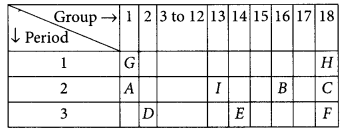
Using the above table answer the following
questions giving reasons in each case :
(i) Which element will form only covalent compounds?
(ii) Which element is a non-metal with valency 2?
(iii) Which element is a metal with valency 2?
(iv) Out of H, C and F which has largest atomic size? (2020)
(v) To which family does H, C and F belong?
Answer:
(i) Element E will form only covalent compounds because it has 4 electrons in the outermost shell so, it can neither loose nor gain 4 electrons, hence E forms compounds by sharing of electrons.
(ii) Element B is a non-metal with valency 2 as it belongs to group 16 (valency = 8 – 6 = 2).
(iii) Element D is a metal with valency two as it belongs to group 2.
(iv) Atomic size increases down the group hence F is largest in size.
(v) H, C and F belongs to noble gas as these are in group-18.
Question 86.
Define atomic size. Give its unit of measurement. In the modern periodic table what trend is observed in the atomic radius in a group and a period and why is it so? (2020)
Answer:
Atomic size : The distance from the center of the nucleus of an isolated atom from outermost shell containing electrons is known as atomic size. The unit of measurement is Angstrom (Å).
Refer to answer 56.
Question 87.
(a) How does metallic character of elements in Modern Periodic Table vary on moving from
(i) left to right in a period
(ii) top to bottom in a group?
Explain with the help of an example in each case.
(b) If an element X is placed in group-14, what will be the nature of bond in its chloride? Write the chemical formula of the compound formed.
(c) An element X has mass number = 35 and number of neutrons = 18. What is the atomic number of X? Write electronic configuration of X and determine its valency. (AI 2019)
Answer:
(a) Refer to answer 40.
Examples:
Variation of metallic character across the period :
Variation of metallic character down the group :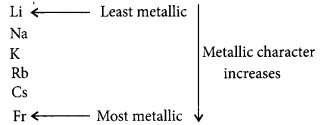
(b) Since element ‘X’ is placed in group 14, therefore, its valency is 14 – 10 = 4. Further, since it is difficult to either lose all the four valence electrons or gain four more electrons, therefore, it prefers to share these four electrons to acquire the stable electronic configuration of the nearest inert gas. Thus, the nature of the chloride of element ‘X is covalent and the chemical formula is XCl4.
(c) Refer to answer 47.
Question 88.
(a) The modern periodic table has been evolved through the early attempts of Dobereiner, Newlands and Mendeleev. List one advantage and one limitation of all the three attempts.
(b) Name the scientist who first of all showed that atomic number of an element is a more fundamental property than its atomic mass.
(c) State modern periodic law.
Answer:
(a) Advantage of Dobereiner’s triads : It recognised a relationship between properties of elements and their atomic weights.
Limitation of Dobereiner’s triads : Dobereiner could identify only three triads. He was not able to prepare triads of all the known elements.
Advantage of Newland’s law of octaves : This law provided a basis for the classification of elements into groups of elements having similar properties.
Limitation of Newlands’ law of octaves : This law worked only for the lighter elements. All the element discovered at that time could not be classified into octaves.
Advantage of Mendeleev’s periodic table : He classified all the 63 elements discovered at that time on the basis of similarities in their properties.
Limitation of Mendeleev’s periodic table : Increasing order of atomic masses could not be maintained in all cases e.g., cobalt with higher atomic mass was placed before nickel.
(b) Henry Moseley, an English physicist, showed that atomic number of an element is a more fundamental property than its atomic mass.
(c) Modern periodic law states that the physical and chemical properties of elements are the periodic function of their atomic numbers.
CBSE Class 10 Science Notes Chapter 5 Periodic Classification of Elements
“The periodic table is a tabular method of displaying the elements in such a way, that the elements having similar properties occur in the same vertical column or group”.
Earlier attempts of the classification of elements: Dobereiner’s Triads, Newland’s law of octaves.
Dobereiner’s Triads: This classification is based on the atomic mass. According to this, when elements are arranged in order of increasing atomic masses, groups of three elements, having similar properties are obtained. The atomic mass of middle element of the triad being nearly equal to the average of the atomic masses of the other two elements.
For Example Li (6.9), Na (23), K (39).
Limitation: It fails to arrange all the known elements in the form of triads, even having similar properties.
Newland’s Law of Octaves: According to this ‘when elements are placed in order of increasing atomic masses, the physical and chemical properties of every 8th element are a repetition of the properties of the first element.’
Form of Newland’s octaves is given in the following table:
Limitations
- Law of octaves was applicable only upto calcium (only for lighter elements).
- Newland adjusted two elements in the same slot (e.g. Co and Ni), having different properties. For example; Co and Ni with Fluorine, Chlorine, Bromine and Iodine.
- According to Newland, only 56 elements existed in nature and no more elements would be discovered in future.
Present attempts for the classification of elements: Mendeleev’s Periodic Table, the Modern Periodic Table.
Mendeleev’s Periodic Table: Mendeleev’s periodic table is based on the physical and chemical properties of elements and their atomic masses.
Mendeleev’s Periodic Law: According to this “The physical and chemical properties of the elements are the periodic function of their atomic masses.”
Periodicity of Properties: The repetition of properties of elements after certain regular intervals is known as Periodicity of Properties.
Merits of Mendeleev’s Periodic Table
- Mendeleev’s left vacant places in his table which provided an idea for the discovery of new elements. Example: Eka-boron, Eka-aluminium and Eka-silicon.
- Mendeleev’s periodic table was predicted properties of several undiscovered elements on the basis of their position in Mendeleev’s periodic table.
- It is useful in correcting the doubtful atomic masses of some elements.
- Noble gases could accommodate in the Mendeleev’s periodic table without disturbing the periodic table after discovery.
Limitations of Mendeleev’s Periodic Table
(a) No fixed position for hydrogen: No correct position of the hydrogen atom was in Mendeleev’s periodic table.
Example: Position of hydrogen with alkali metals and halogens (17th group).
(b) No place for isotopes: Position of isotopes were not decided.
Example: Cl-35 and Cl-37.
(c) No regular trend in atomic mass: Position of some elements with lower atomic masses before with higher atomic mass.
Example: Ni-58.7 before Co-58.9.
Mendeleev’s original periodic table is reproduced in the table below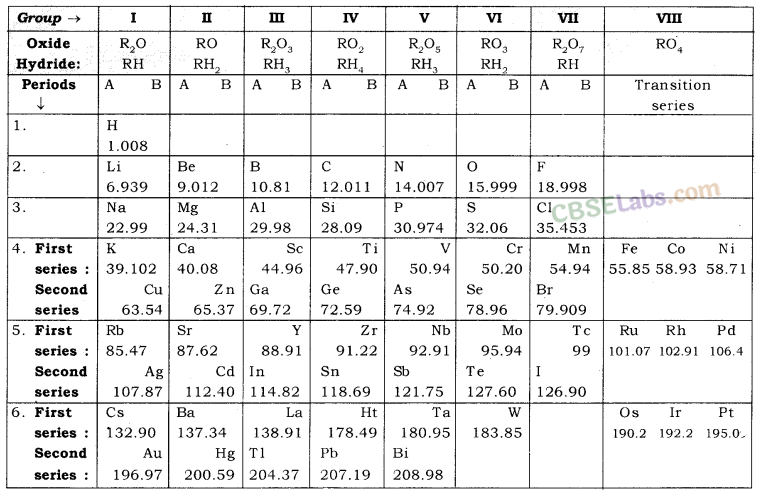
The Modern Periodic Table: In 1913, Henry Moseley showed that the atomic number of an element is a more fundamental property than its atomic mass.
Modern Period Law: The physical and chemical properties of elements are the periodic function of their atomic number.
Modern periodic table is based on atomic number of elements.
Atomic number (Z) is equal to the number of protons present in the nucleus of an atom of an element.
Modern periodic table contains 18 vertical column known as group and seven horizontal rows known as periods.
On moving from left to right in a period, the number of valence electrons increases from 1 to 8 in the elements present.
On moving from left to right in a period, number of shell remains same.
All the elements of a group of the periodic table have the same number of valence electrons.
Trends in Modern Periodic Table: Valency, Atomic size, metallic and non-metallic characters, and Electronegativity.
(i) Valency: The valency of an element is determined by the number of valence electrons present in the outermost shell of its atom (i.e. the combining capacity of an element is known as its valency).
In Period: On moving from left to right in a period, the valency first increases from 1 to 4 and then decreases to zero (0).
In Groups: On moving from top to bottom in a group, the valency remains same because the number of valence electrons remains the same.
Example: Valency of first group elements = 1 Valency of second group elements = 2.
(ii) Atomic size: Atomic size refers to radius of an atom. It is a distance between the centre of the nucleus and the outermost shell of an isolated atom.
In Period : On moving from left to right in a period, atomic size decreases because nuclear charge increases.
Example: Size of second period elements: Li > Be > B > C > N > O > F
Point to know: The atomic size of noble gases in corresponding period is largest
due to presence of fully filled electronic configuration (i.e. complete octet).
In Group: Atomic size increases down the group because new shells are being
added in spite of the increase in nuclear charge.
Example ; Atomic size of first group element : Li < Na < K < Rb < Cs < Fr
Atomic size of 17th group elements : F < Cl < Br < I
(iii) Metallic character: It is the tendency of an atom to lose electrons. In Period: Along the period from left to right, metallic characters decreases because a tendency to lose electron decreases due to the increase in nuclear charge. Example: Metallic character of second period elements: Li > Be > B > C >> N > O > F
In Group: Metallic character, when moving from top to bottom increases because the atomic size and tendency to lose electrons increases.
Example: First group element : Li < Na < K < Rb < Cs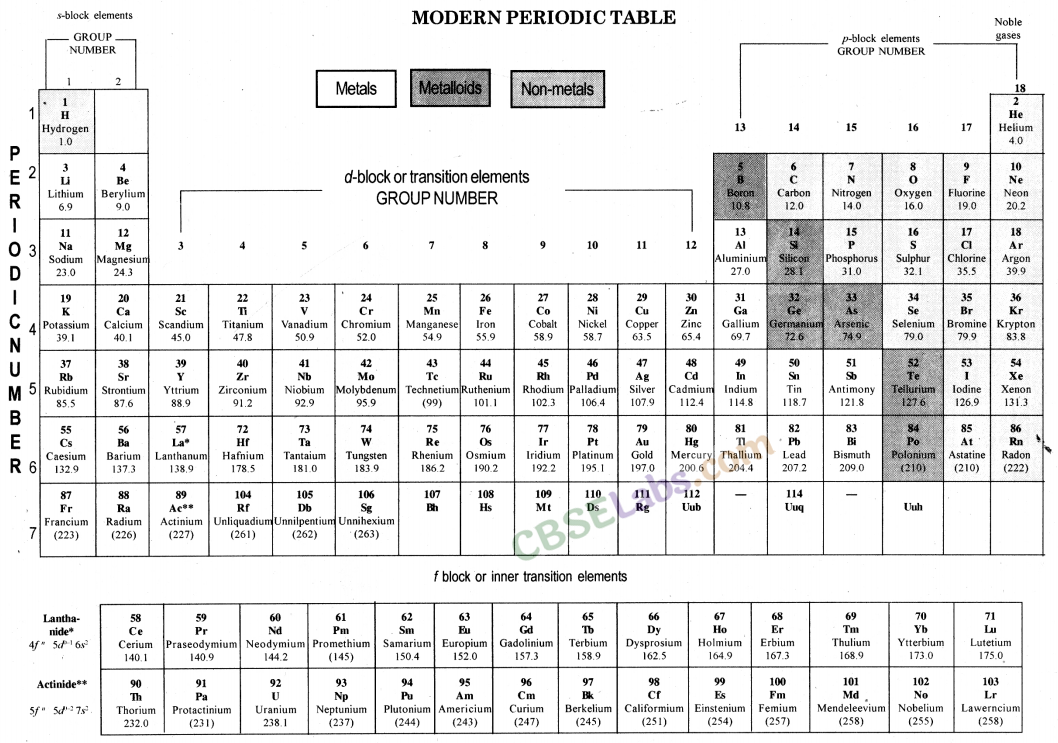
17th group elements: F < Cl < Br < I
(iv) Non-metallic character: It is tendency of an atom to gain electrons.
In Period: Along the period from left to right, non-metallic character increases because tendency to gain electrons increases due to increase in nucleus charge. Example ; Non-metallic character of 2nd period elements : Li < Be < B < C < N < O < F In Group: On moving from top to bottom in a group, non-metallic character decreases because atomic size increases and tendency to gain electrons decreases. Ex. Non-metallic character of 17th period element: F > Cl > Br > I
(v) Chemical Reactivity
In metals: Chemical reactivity of metals increases down the group because tendency to lose electrons increases. Example ; Li < Na < K < Rb < Cs (1st group) In non-metals: Chemical reactivity of non-metals decreases down the group because tendency to gain electrons decreases. Example: F > Cl > Br > I (17th group)
(vi) Electronegativity: It is tendency of an element to attract the shared pair of electrons towards it in a covalently bonded molecule. It increases with increase of nuclear charge or decrease in atomic size.
Along the period electronegativity increases. Example ;Li < Be < B < C < N < O < F. Down the group electronegativity decreases. Example ; Li > Na > K > Rb > Cs
F > Cl > Br > I
(vii) Nature of Oxides: Metal oxides are basic in nature. Ex. Na2O, MgO etc.
Non-metal oxides are acidic in nature. Ex. Cl2O7, SO3, P2O5,
In the case of metal reactivity, it increases down the group because of the tendency to lose electrons increases.
In the case of non-metal reactivity, decreases down the group because of the tendency to gain electrons decreases.
Group: The vertical columns in Mendeleev’s, as well as in Modern Periodic Table, are called groups.
Period: The horizontal rows in the Modern Periodic Table and Mendeleev’s Periodic Table are called periods.
There are 18 groups and 7 (seven) periods in the Modern Periodic Table.
Atomic size: The atomic size may be visualised as the distance between the centre of the nucleus and the outermost shell of an isolated atom.
The trend of atomic size (radius) in moving down a group: Ongoing down in a group of the Periodic Table, the atomic size increases because a new shell of electrons is added to the atoms at every step. There is an increase in distance between the outermost shell electrons and the nucleus of the atom.
The trend of atomic size (radius) in moving from left to right in a period: On moving from left to right along a period, the size of atoms decreases because on moving from left to right, the atomic number of elements increases which means that the number of protons and electrons in the atoms increases. Due to the large positive charge on the nucleus, the electrons are pulled in more closely to the nucleus and the size of the atom decreases.
Characteristics of triads of J.W. Dobereiner.
- Elements of a triad show similar chemical properties.
- These elements of a triad show specific trends in their physical properties.
- The atomic mass of the middle element was roughly the average of the atomic masses of the other two elements.
Example: Atomic mass of Na is 23 in the triad Li, Na and K. This atomic mass is the average of the atomic masses of Li and K which have atomic masses 7 and 39 respectively.
Triads as formed by Dobereiner.
1st Triad
Li – Lithium
Na – Sodium
K – Potassium
2nd Triad
Ca – Calcium
Sr – Strontium
Ba – Barium
3rd Triad
Cl – Chlorine
Br – Bromine
I – Iodine
Mendeleev’s Periodic Law: It states that “the properties of elements are the periodic functions of their atomic masses.” It means the properties of the elements depend on their atomic masses and the elements are given a position in the periodic table on the basis of their increasing atomic masses.
Merits of Mendeleev’s Periodic Table
(i) Mendeleev left a number of gaps in his table to accommodate the new elements which would be discovered later on. So Mendeleev boldly predicted the existence of some more elements. He even predicted the properties of some of these elements and named them as Eka-boron, Eka-aluminium and Eka-silicon respectively. Later on the elements were discovered, for example, gallium replaced Eka-aluminium and it showed properties similar to that of aluminium.
(ii) He gave the proper position to the noble gases which were discovered later on, without disturbing the existing order of elements. He placed them in a new group.
Limitations of Mendeleev’s classification:
- The position of isotopes could not be explained because isotopes have the same chemical properties but different atomic masses. If the elements are arranged according to atomic masses, the isotopes should be placed in different groups of the Periodic Table.
- The atomic masses do not increase in a regular manner in going from one element to the next.
- He could not assign a correct position to hydrogen in his table because hydrogen has some properties similar to alkali metals and some properties similar to halogens.
Modem Periodic Law: This law was proposed by Henry Moseley, a scientist in 1913. According to this Law, “Properties of elements are the periodic function of their atomic number.” It means that the properties of elements depend on their atomic number and the elements are given positions in the periodic table on the basis of their increasing atomic number. As atomic number determines the distribution of electrons in the orbits, and electrons of the outermost orbit determine the properties of an element.
Groups and periods in the Modem (long form) Periodic Table: There are 18 groups (vertical columns) and 7 periods (horizontal lines) in the Modern (or long form) Periodic Table. The number of the period is equal to the number of shells in the atoms of the elements belonging to that period.
Trends in Mendeleev’s Periodic Table
- The properties of elements are periodic functions of their atomic mass.
- It has 8 groups.
- No place could be assigned to isotopes of an element.
- There were three gaps left by Mendeleev in his Periodic Table.
- No fixed position was given to hydrogen in this Periodic Table.
- No distinction was made between metals and non-metals.
- Transition elements are placed together in Group VIII.
- Inert gases were not known at the time of Mendeleev.
Trends in Modem Periodic Table
(i) Valency: Elements belonging to the same group have the same number of valence electrons and thus the same valency. Valency in a particular period from left to right first increases as positive valency and then decreases as negative valency.
Example: In elements of 2nd period:
Li has 1+ valency, then Be2+, B3+, C4+ covalency, N3- valency, then O2- and F(-) valency.
(ii) The atomic size or atomic radius increases: as we move down in a group and it decreases as we move from left to right in a period. Atomic size increases down a group due to the increase in the number of shells. Atomic size decreases along a period due to an increase in the nuclear charge which tends to pull the electrons closer to the nucleus and reduces the size of the atom.
(iii) Metallic and Non-Metallic properties: In the modern periodic table metals are on the left side and non-metals on the right side of the table. A zig-zag line of metalloids separates metals from non-metals.
- Metallic characters decrease from left to right in a period and increase while going down in a group.
- Non-metallic characters increase from left to right in a period due to increase in the electronegativity and these characters decrease from top to bottom in a group due to the decrease in the electronegativity of atoms while going down in a group.
1. Need for classification of elements:
Increase in the discovery of different elements made it difficult to organise all that was known about the elements. To study a large number of elements with ease, various attempts were made. The attempts resulted in the classification of elements into metals and non-metals.
2. Dobereiner’s triads:
Johann Wolfgang Dobereiner, a German chemist, classified the known elements in groups of three elements on the basis of similarities in their properties. These groups were called triads.
(i) Characteristics of Triads:
- Properties of elements in each triad were similar.
- Atomic mass of the middle element was roughly the average of the atomic masses of the other two elements.
(ii) Examples of Triads:
(iii) Limitations: Dobereiner could identify only three triads. He was not able to prepare triads of all the known elements.
3. Newlands’ Law of Octaves:
John Newlands’, an English scientist, arranged the known elements in the order of increasing atomic masses and called it the ‘Law of Octaves’. It is known as ‘Newlands’ Law of Octaves’.
(i) Characteristics of Newlands’ Law of Octaves:
- It contained the elements from hydrogen to thorium.
- Properties of every eighth element were similar to that of the first element.
(ii) Table showing Newlands’ Octaves: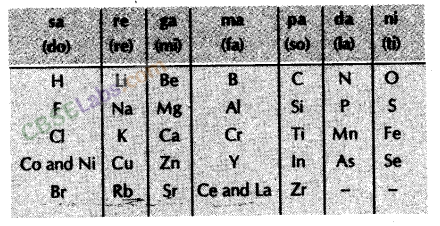
(iii) Limitations of Newlands’ law of Octaves:
- The law was applicable to elements up to calcium (Ca).
- It contained only 56 elements.
- In order to fit elements into the table, Newlands’ adjusted two elements like cobalt and nickel in die the same slot and also put some unlike elements under the same note.
4. Mendeleev’s Periodic Table: Dmitri Ivanovich – 5 ’ Mendeleev, a Russian demist, was the most important contributor to the early development of a periodic table of elements wherein the elements were arranged on the basis of their atomic mass and chemical properties.
- Characteristics of Mendeleev’s Periodic Table:
- Mendeleev arranged all the 63 known elements in increasing order of their atomic masses.
- The table contained vertical columns called ‘groups’ and horizontal rows called ‘periods’.
- The elements with similar physical and chemical properties came under the same groups.
- Mendeleev’s Periodic Law: The properties of elements are the periodic function of their atomic masses.
- Achievements of Mendeleev’s Periodic Table:
- Through this table, it was very easy to study the physical and chemical properties of various elements.
- Mendeleev adjusted few elements with a slightly greater atomic mass before the elements with slightly lower atomic mass, so that elements with similar properties could be grouped together. For example, aluminium appeared before silicon, cobalt appeared before nickel.
- Mendeleev left some gaps in his periodic table.
He predicted the existence of some elements that had not been discovered at that time. His predictions were quite true as elements like scandium, gallium and germanium were discovered later. - The gases like helium, neon and argon, which were discovered later, were placed in a new group without disturbing the existing order.
- Limitations:
- No fixed positions were given to hydrogen in the Mendeleev’s periodic table.
- Positions of Isotopes of all elements was not certain according to Mendeleev’s periodic table.
- Atomic masses did not increase in a regular manner in going from one element to the next.
5. Modem Periodic Table: Henry Moseley, gave a new ! property of elements, ‘atomic number’ and this was I adopted as the basis of Modem Periodic Table.
(i) Modem Periodic Law: Properties of elements are a periodic function of i their atomic number.
(ii) The position of elements in Modem Periodic Table:
- The modem periodic table consists of 18 groups and 7 periods.
- Elements present in any one group have the same number of valence electrons. Also, the number of shells increases as we go down the group.
- Elements present in any one period, contain the same number of shells. Also, with increase in atomic number by one unit on moving from left to right, the valence shell electrons increases by one unit.
- Each period marks a new electronic shell getting filled.
(iii) Table showing Electronic Configuration of First 20 Elements: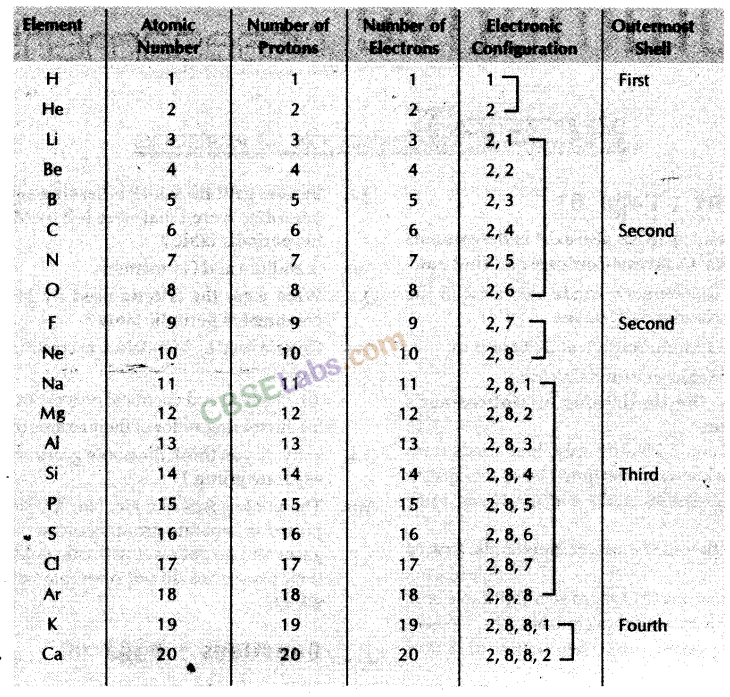
Trends in the Modern Periodic Table:
- Valency: Valency of an element is determined by the number of valence electrons present in the outermost shell of its atom.
- Valency of elements in a particular group is same.
- Valency of elements in a period first increases from one to four and then decreases to zero.
- Atomic Size: Atomic size refers to the radius of an atom.
- In a period, atomic size and radii decreases from left to right.
- In a group, atomic size and radii increases from top to bottom.
Metallic and Non-metallic Properties:
- The tendency to lose electrons from the outermost shell of an atom, is called metallic character of an element.
- The tendency to gain electrons from the outermost shell of an atom, is called non-metallic character of an element.
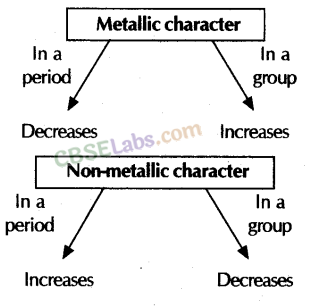
NCERT Exemplar Class 10 Science Chapter 5 Periodic Classification of Elements
Short Answer Questions
Question.1 “Hydrogen occupies a unique position in the Modern Periodic Table”. Justify the statement.
Answer. Hydrogen resembles with both group 1 (Alkali metals) as well as group 17 (Halogens), therefore, it occupies a unique position in the Modern Periodic Table.
Question.2 Write the formula of chlorides of Eka-silicon and Eka-aluminium, the elements predicted by Mendeleev.
Answer.
Germanium is Eka-silicon. The formula isGeCl4.
Gallium is Eka-aluminium. The formula is GaCl3.
Question.3 Three elements A, B and C have 3, 4 and 2 electrons respectively in their outermost shell. Give the group number to which they belong in the Modern Periodic Table. Also, give their valencies
Answer.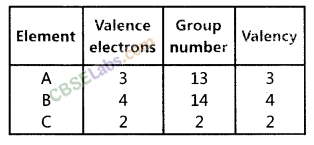
Question.4 If an element X is placed in group 14, what will be the formula and the nature of bonding of its chloride?
Answer.‘X’ belongs to group 14, it has four valence electrons and valency is equal to 4.
The nature of bond is covalent.
Question.5 Compare the radii of two species X and Y. Give reasons for your answer.
(a) X has 12 protons and 12 electrons
(b) Y has 12 protons and 10 electrons
Answer. ‘X’ has 12 protons and 12 electrons. It has bigger atomic size as compared to
‘Y’ which has 12 protons and 10 electrons because effective nuclear charge is less in X than Y. Secondly, number of shells are more in ‘X’ than ‘Y’.
Therefore,
(a) ‘X’ has bigger atomic size.
(b) Y has smaller size as compared to ‘X’.
Question.6 Arrange the following elements in increasing order of their atomic radii,
(a) Li, Be, F, N
(b) Cl, At, Br, I
Answer. (a) F < N < Be < Li is increasing order of atomic size because atomic size decreases along a period from left to right.
(b) Cl < Br < I < At is increasing order of atomic size because atomic size increases down the group due to increase in number of shells.
Question.7 Identify and name the metals out of the following elements whose electronic configurations are given below.
(a) 2, 8, 2 (b) 2, 8. 1
(c) 2.8. 7 (d) 2. 1
Answer. (a) Magnesium (b) Sodium (c) Chlorine (d) Lithium
Metals are (a) Magnesium, (b) Sodium and (d) Lithium as they have 1 to 3 valence electrons. Whereas, (c) chlorine is a non-metal.
Question.8 Write the formula of the product formed when the element A (atomic number 19) combines with the element B (atomic number 17). Draw its electronic dot structure. What is the nature of the bond formed?
Answer.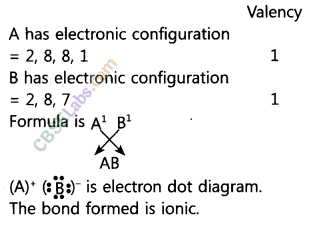
Question.9 Arrange the following elements in the increasing order of their metallic character: Mg, Ca, K, Ge, Ga.
Answer. Ge < Ga < Mg < Ca < K is increasing order of metallic character. It is because ‘K’ can lose electron more easily due to larger size whereas, ‘Ge’ is smallest and cannot lose electrons.
Long Answer Questions
Question.10. An element is placed in 2nd Group and 3rd Period of the Periodic Table, burns in presence of oxygen to form a basic oxide,
(a) Identify the element.
(b) Write the electronic configuration.
(c) Write the balanced equation when it burns in the presence of air.
(d) Write a balanced equation when this oxide is dissolved in water.
(e) Draw the electron dot structure for the formation of this oxide.
Answer.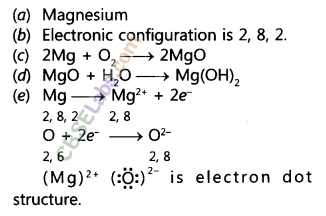
Question.11. An element X (atomic number 17) reacts with an element Y (atomic number 20) to form a divalent halide.
(a) Where in the periodic table are elements X and Y placed?
(b) Classify X and Y as metal(s), non- metal(s) or metalloid(s).
(c) What will be the nature of oxide of element Y? Identify the nature of bonding in the compound formed.
(d) Draw the electron dot structure of the divalent halide.
Answer.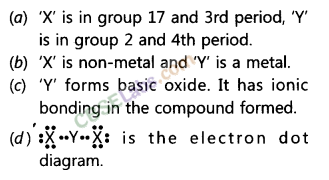
(a) ‘X’ is in group 17 and 3rd period, ‘Y’ is in group 2 and 4th period.
(b) ‘X’ is non-metal and ‘Y’ is a metal.
(c) ‘Y’ forms basic oxide. It has ionic bonding in the compound formed.
(d) :X“Y”X: is the electron dot diagram.
Question.12. Atomic number of a few elements are given below.
10, 20, 7, 14
(a) Identify the elements. .
(b) Identify the Group number of these elements in the Periodic Table.
(c) Identify the Periods of these elements in the Periodic Table.
(d) What would be the electronic configuration for each of these elements?
(e) Determine the valency of these elements.
Answer.
Question.13 (i) Electropositive nature of the elements(s) increases down the group and decreases across the period.
(ii) Electronegativity of the element decreases down the group and increases across the period.
(iii) Atomic size increases down the group and decreases across a period (left to right).
(iv) Metallic character increases down the group and decreases across a period.
On the basis of the above trends of the Periodic Table, answer the following about the elements with atomic numbers 3 to 9.
(a) Name the most electropositive element among them.
(b) Name the most electronegative element.
(c) Name the element with smallest atomic size.
(d) Name the element which is a metalloid.
(e) Name the element which shows maximum valency.
Answer.
(a) Lithium (3)
(b) Fluorine (9)
(c) Fluorine (9)
(d) Boron (5)
(e) Carbon (6). Its valency is 4.
Question.14 An element X which is a yellow solid at room temperature shows catenation and allotropy. X forms two oxides which are also formed during the thermal decomposition of ferrous sulphate crystals and are the major air pollutants.
(a) Identify the element X.
(b) Write the electronic configuration of X.
(c) Write the balanced chemical equa-tion for the thermal decomposition of ferrous sulphate crystals.
(d) What would be the nature (acidic/ basic) of oxides formed?
(e) Locate the position of the element in the Modern Periodic Table.
Answer.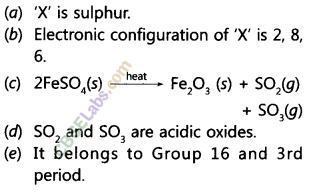
Question.15 An element X of group 15 exists as diatomic molecule and combines with hydrogen at 773 K in presence of the catalyst to form a compound, ammonia which has a characteristic pungent smell.
(a) Identify the element X. How many valence electrons does it have?
(b) Draw the electron dot structure of the diatomic molecule of X. What type of bond is formed in it?
(c) Draw the electron dot structure for ammonia and what type of bond is formed in it? .
Answer.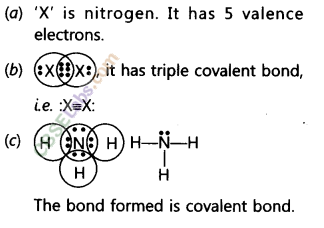
Periodic Classification of Element – CBSE Class 10 Science – Extra Questions
According to new CBSE Exam Pattern, MCQ Questions for Class 10 Science pdf Carries 20 Marks.
Question-1
What are the merits and demerits of newland’s classification?
Solution:
Merits
(i) This classification worked well for lighter elements only up to Ca.
(ii) This classification gave us a relation between the properties of the elements and their atomic masses.
(iii) It was shown by this classification for the first time that there exists a periodicity in the properties of the elements.
Demerits
(i) This classification failed when the heavier elements beyond Ca were arranged according to Newland’s law of octaves.
(ii) At the time of this law, noble gases were unknown. When noble gases were discovered, neon (Ne) between F and Na, and argon (Ar) between Cl and K, it becomes the ninth element and not the eighth which has the similar properties.
Question-2
X and Y are two elements having which have similar properties and obey Newland’s land of octaves. How many elements are there in-between X and Y?
Solution:
The law states there are eight elements in an octave (row). No of elements between X and Y is six.
Question-3
What is achievement of Dobereiner’s law of traids?
Solution:
The law recognised the relation between atomic weight of an element and its chemical properties for the first time.
Question-4
Lithium, Sodium and potassium were put in the same group on the basis of their similar properties.
i) What is the similarity in their properties?
Solution:
i) Li, Na and K are very reactive alkali metals, which react with water with the formation of an alkali and hydrogen gas.
Question-5
State two reasons for rejecting law of octaves.
Solution:
(i) The law did not extend properly beyond the element calcium.
(ii) The law did not provide any specific place for hydrogen.
Question-6
Name four alkaline earth metals. To which group do they belong?
Solution:
The four alkaline earth metals are beryllium, magnesium, calcium and strontium. They belong to II A group.
Question-7
What is called diagonal relationship?
Solution:
The similarity in properties between certain elements of different periods placed diagonally to one another in a periodic table is called diagonal relationship.
Question-8
Define electron affinity.
Solution:
It is defined as the amount of energy released in adding an extra electron to an isolated neutral gaseous atom in its lowest energy state, to convert it into gaseous ion. Electron affinity increases as one moves from left to right in periods or top to bottom in groups.
Question-9
What is called electronegativity?
Solution:
The property of atoms to attract electrons in a covalent bond is called electronegativity.
(i) In periods, electronegativity increases with the increase in atomic number.
(ii) In groups, electronegativity decreases with the increase in atomic number.
Question-10
(a) Name an alkali metal other than lithium, sodium and potassium.
(b) Name an alkaline earth metals other than calcium, strontium and barium.
(c) Name one halogen other than chlorine, bromine and iodine.
(d) Name a non-metal having properties similar to carbon.
(e) Name a rare gas other than neon, krypton and xenon.
Solution:
(a) Rubidium
(b) Magnesium
(c) Fluorine
(d) Silicon
(e) Argon.
Question-11
Explain why the following statements are not correct?
i) All groups contain both metals and non-metals
ii) In group I, reactivity decreases with increases in atomic number
iii) Elements in a period become more metallic with increasing atomic number
iv) Atoms of elements in the same group have the same number of electrons.
Solution:
i) All groups do not contain both metals and non-metals. Group I and II contain only metals.
ii) In group I, reactivity increases with increase in atomic number. This is because as the size of the atoms increases, the valence shell electrons can be easily removed.
iii) The metallic character decreases in a period with increase in atomic number. This is because across the period, the size of the atom decreases and the valence shell electrons are held more tightly.
iv) In a neutral atom the number of electrons is equal to the number of protons. In a group the atomic number increases as we move down.
Question-12
Why are the elements sodium and chlorine in the same period of the Periodic table?
Solution:
This is because the atoms of both the elements have three shells containing the electrons.
NCERT Solutions for Class 10 Science All Subject NCERT Solutions
- Chapter 1 Chemical Reactions and Equations
- Chapter 2 Acids, Bases and Salts
- Chapter 3 Metals and Non-metals
- Chapter 4 Carbon and Its Compounds
- Chapter 5 Periodic Classification of Elements
- Chapter 6 Life Processes
- Chapter 7 Control and Coordination
- Chapter 8 How do Organisms Reproduce?
- Chapter 9 Heredity and Evolution
- Chapter 10 Light Reflection and Refraction
- Chapter 11 Human Eye and Colourful World
- Chapter 12 Electricity
- Chapter 13 Magnetic Effects of Electric Current
- Chapter 14 Sources of Energy
- Chapter 15 Our Environment
- Chapter 16 Management of Natural Resources
.png)
.png)